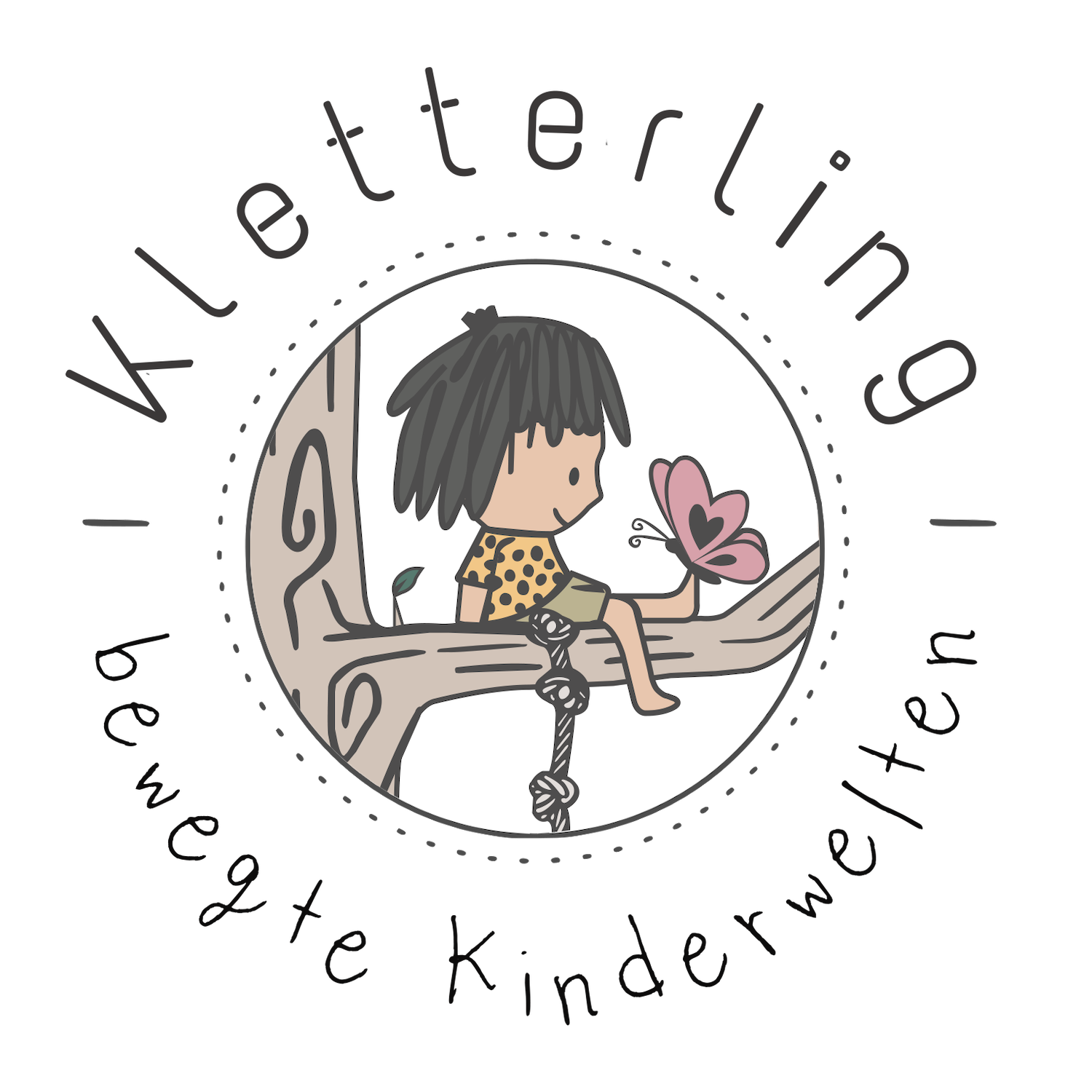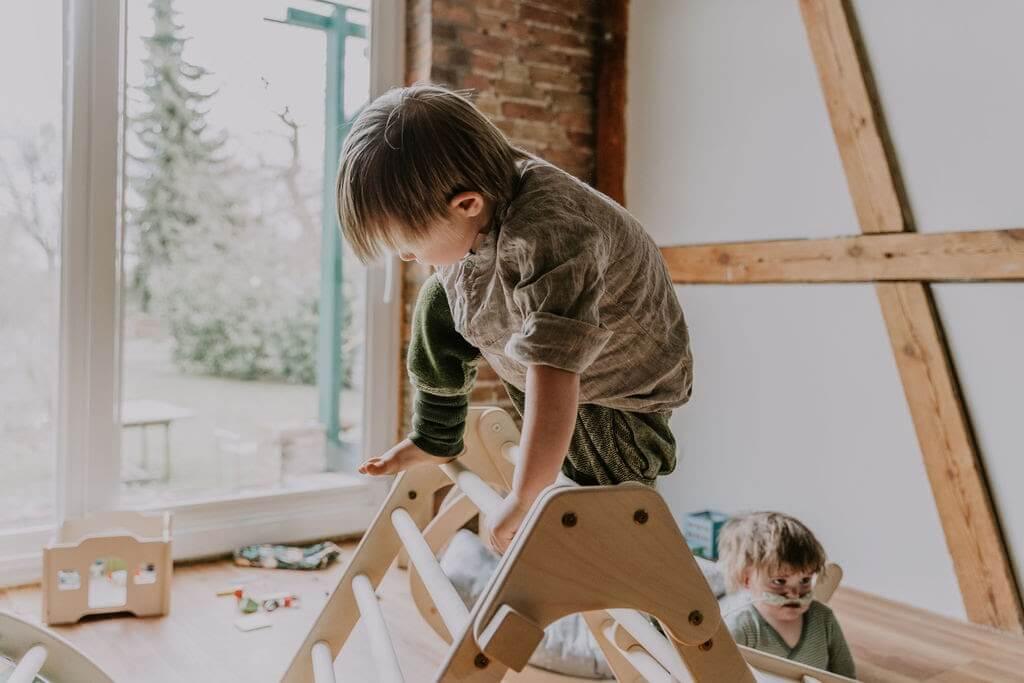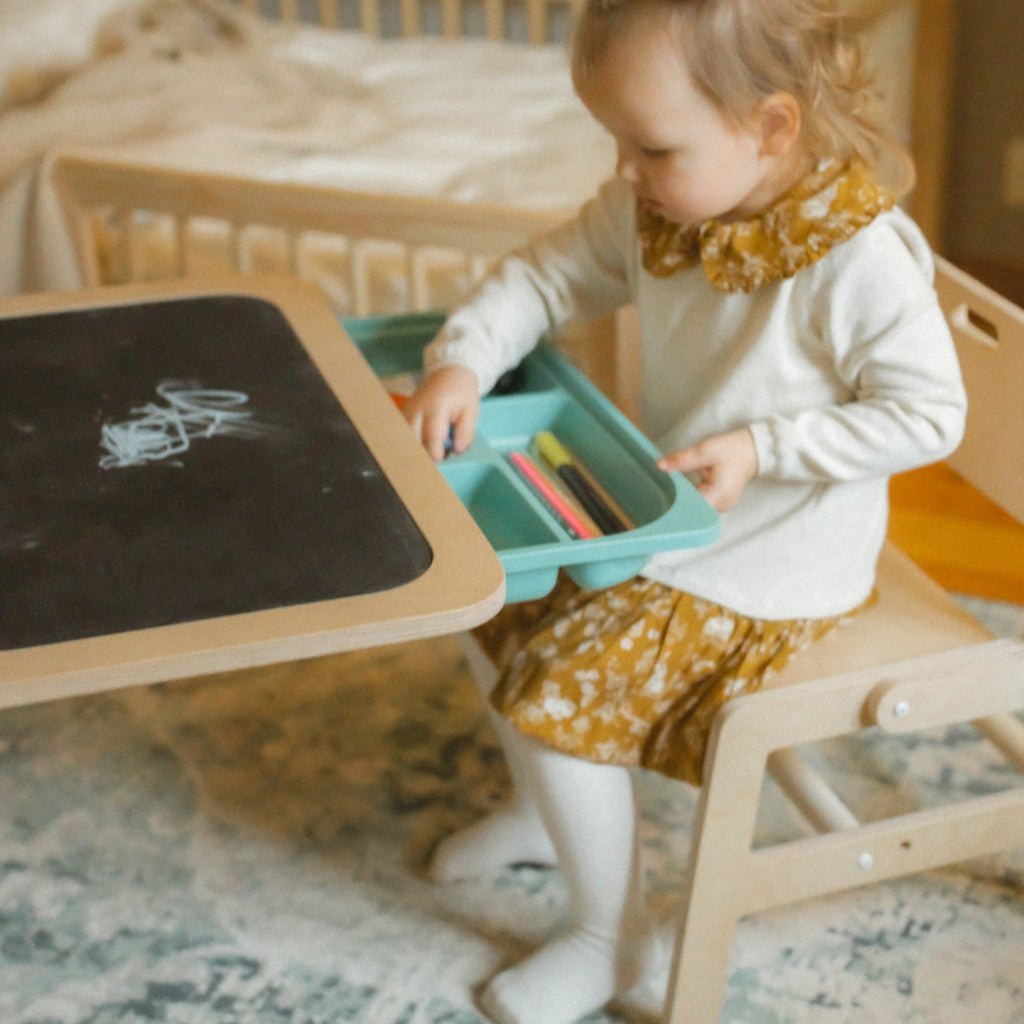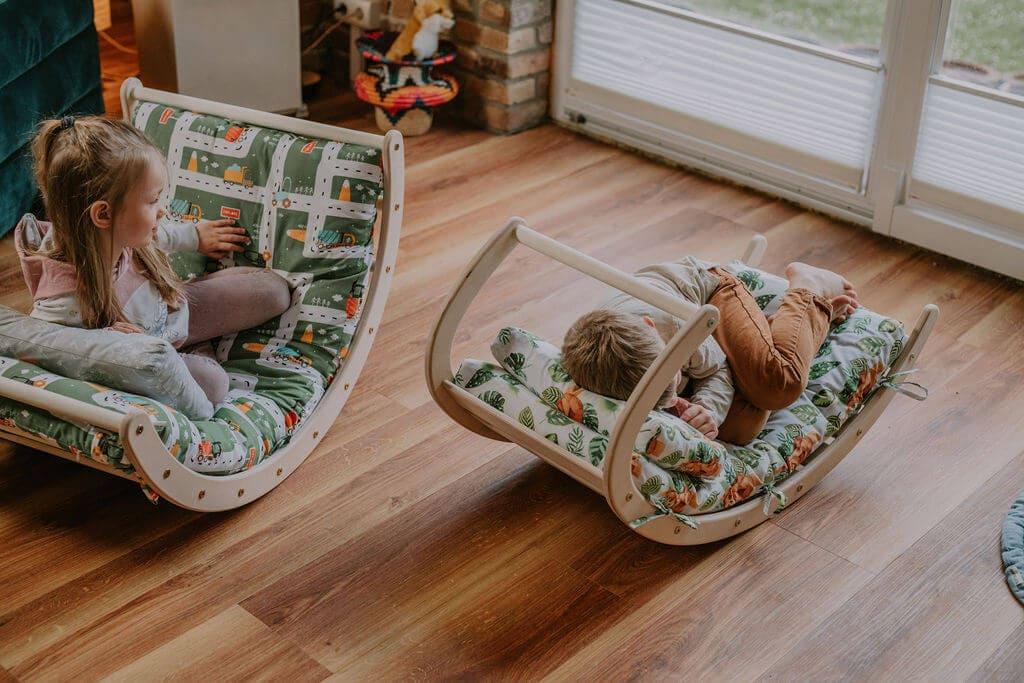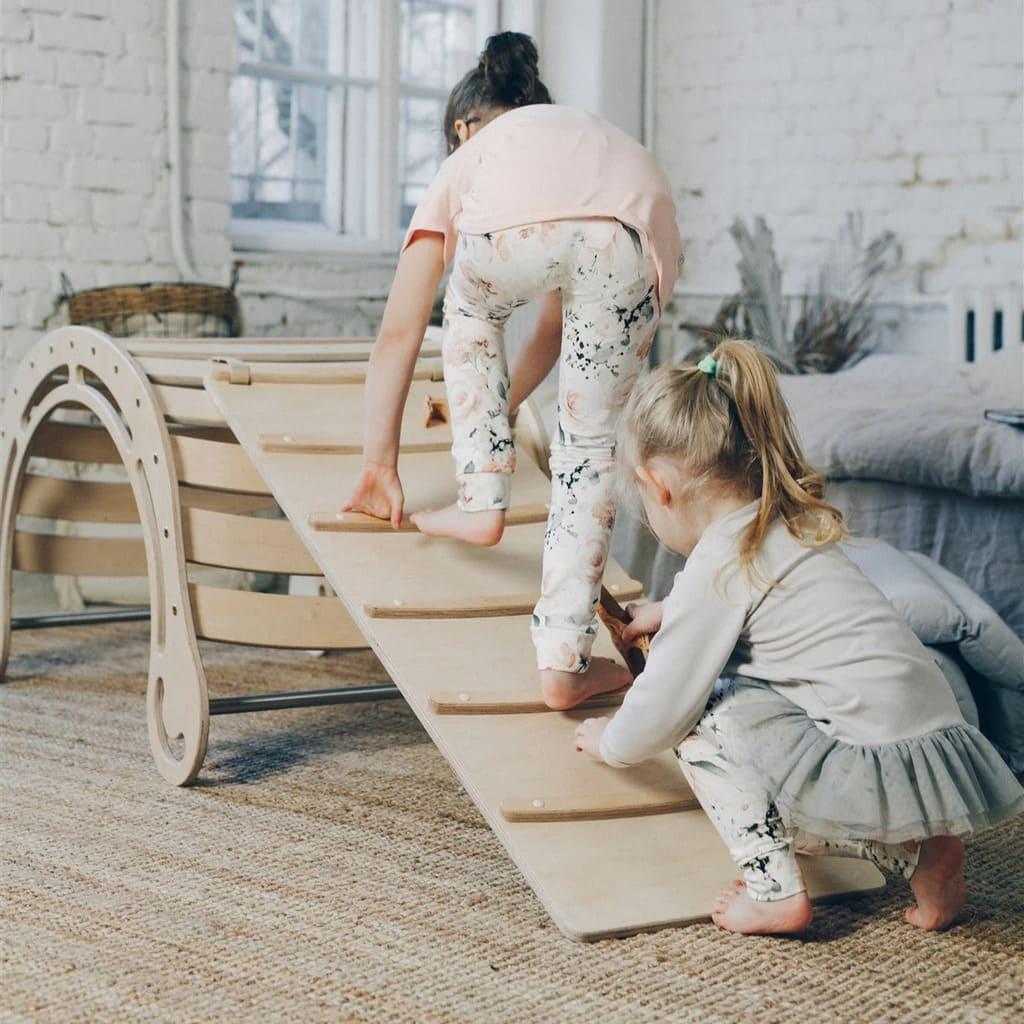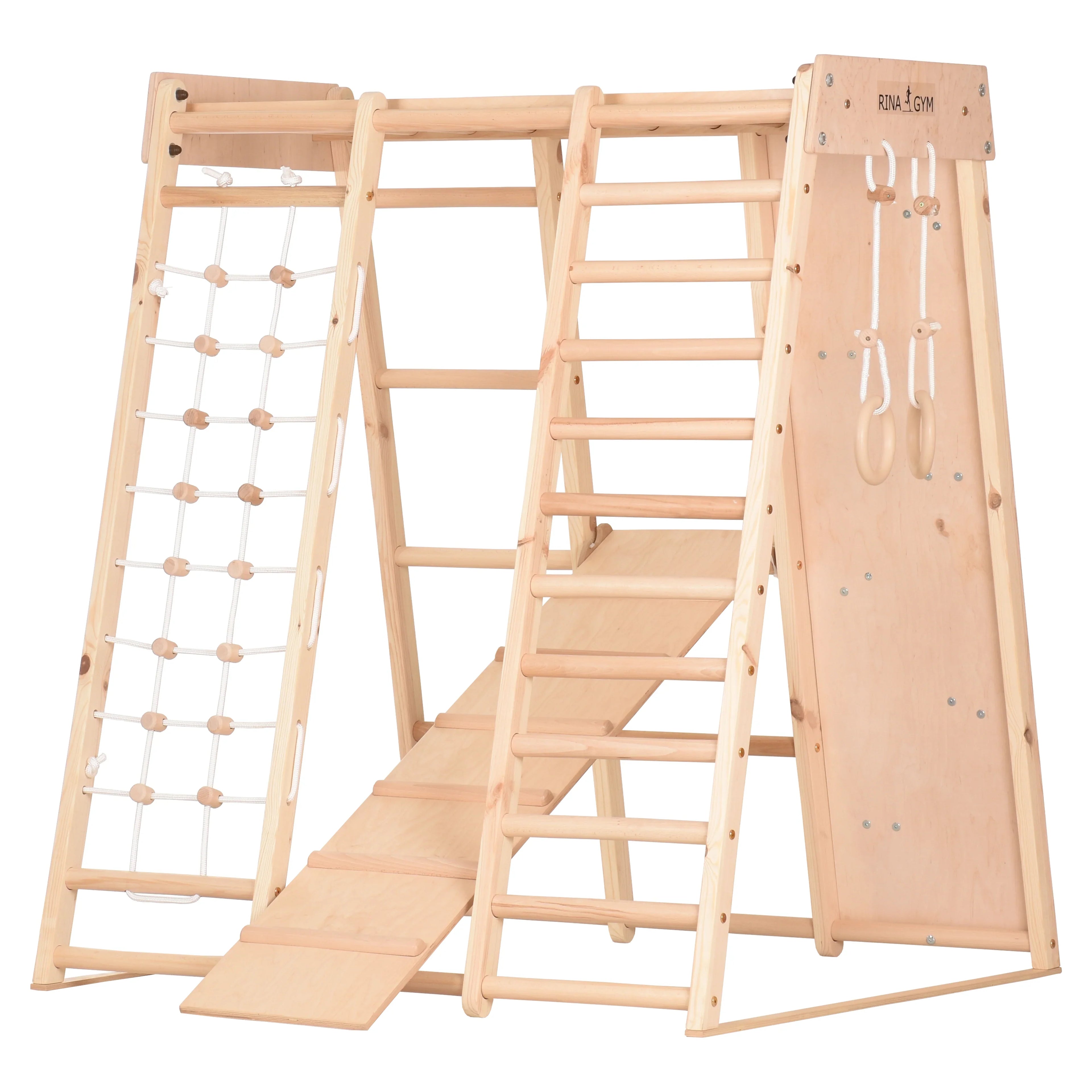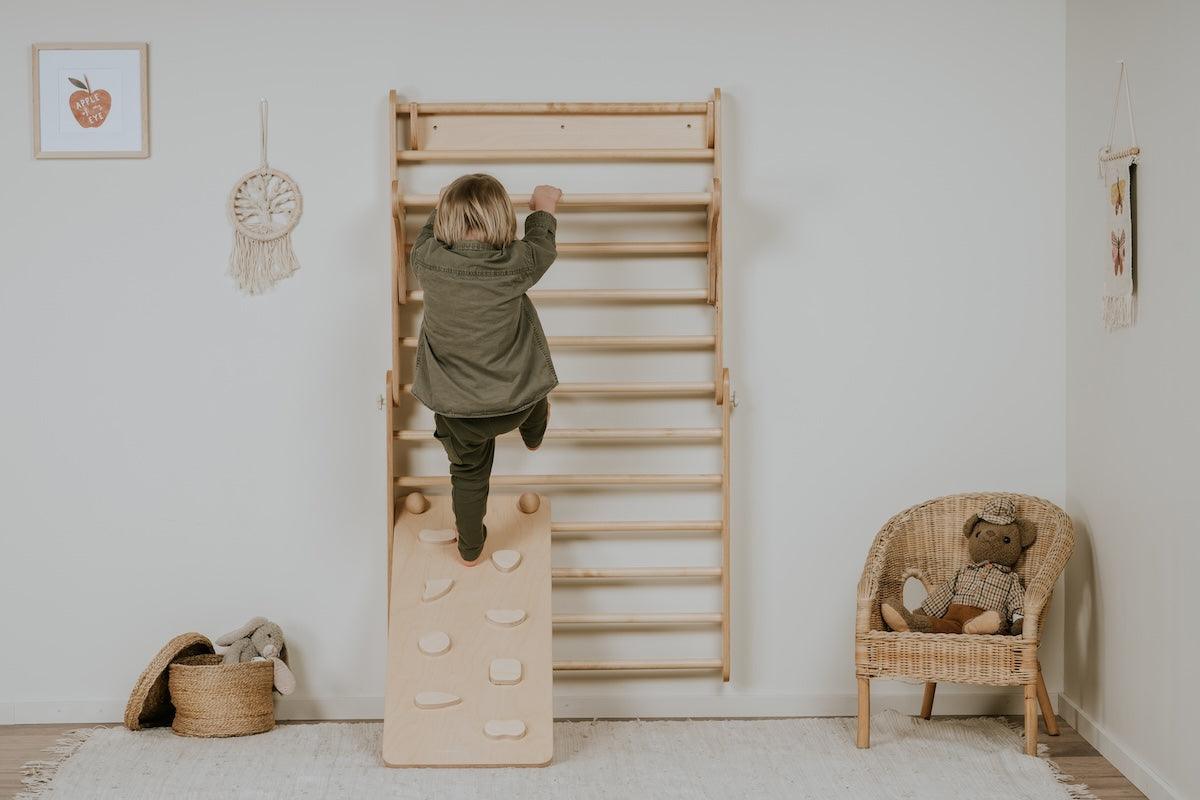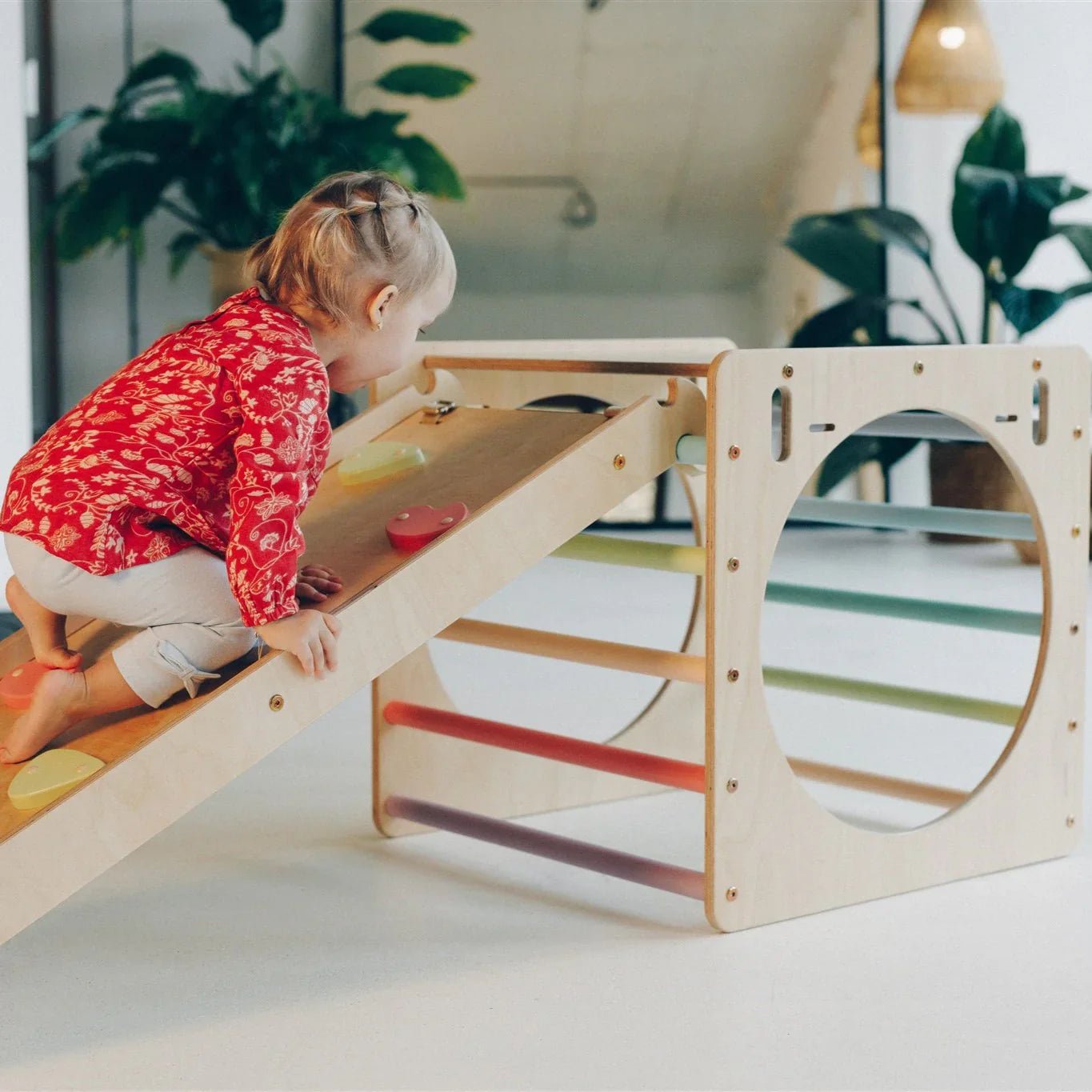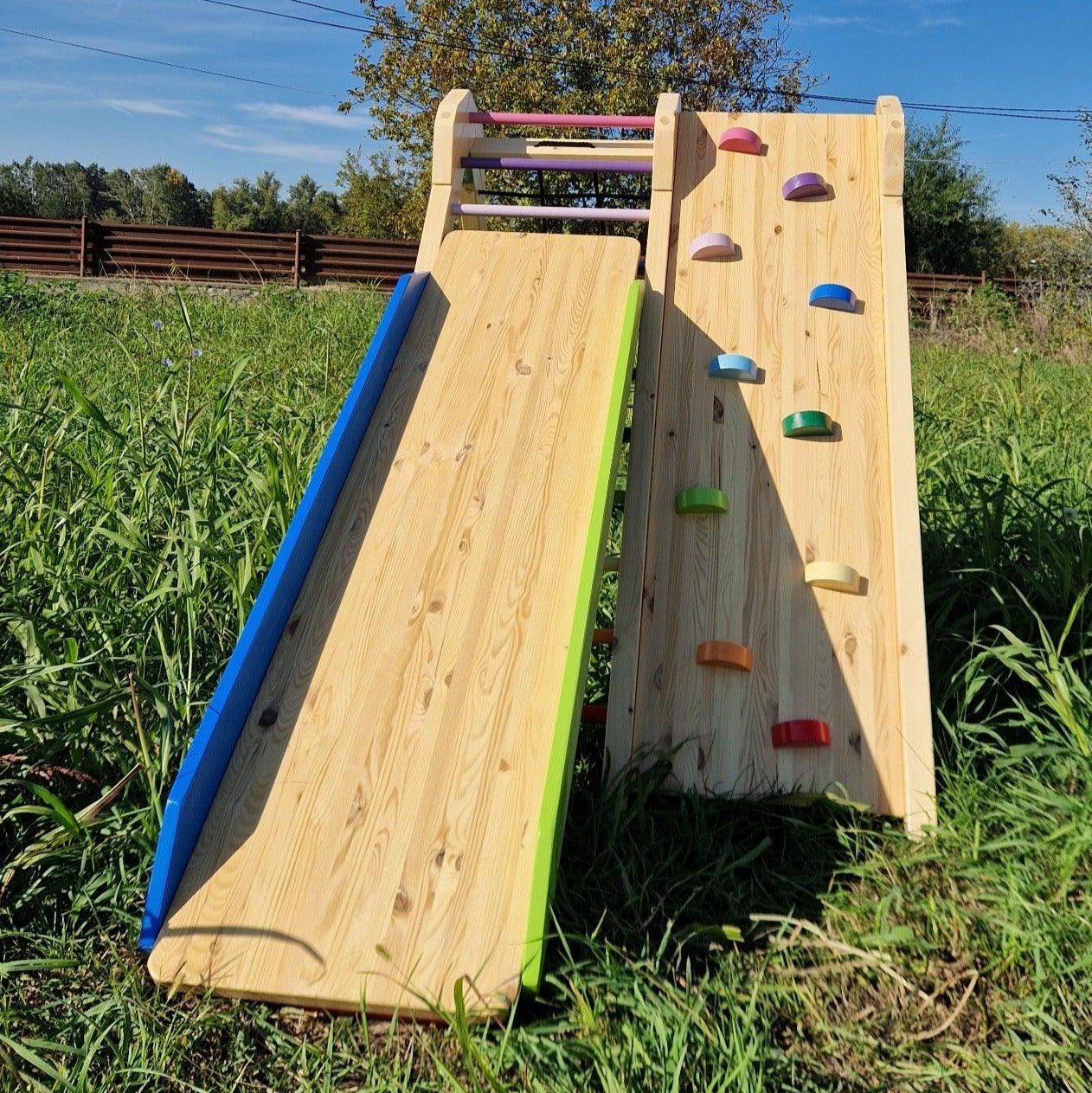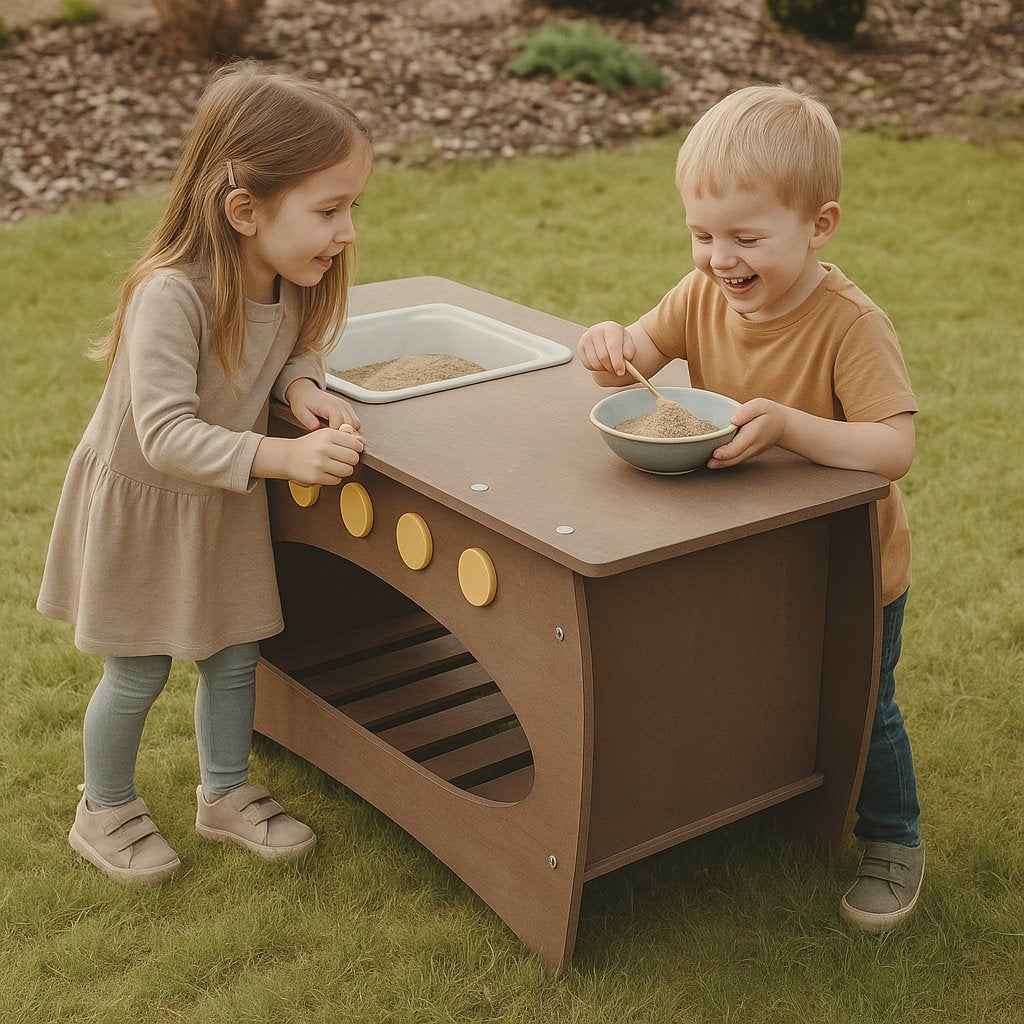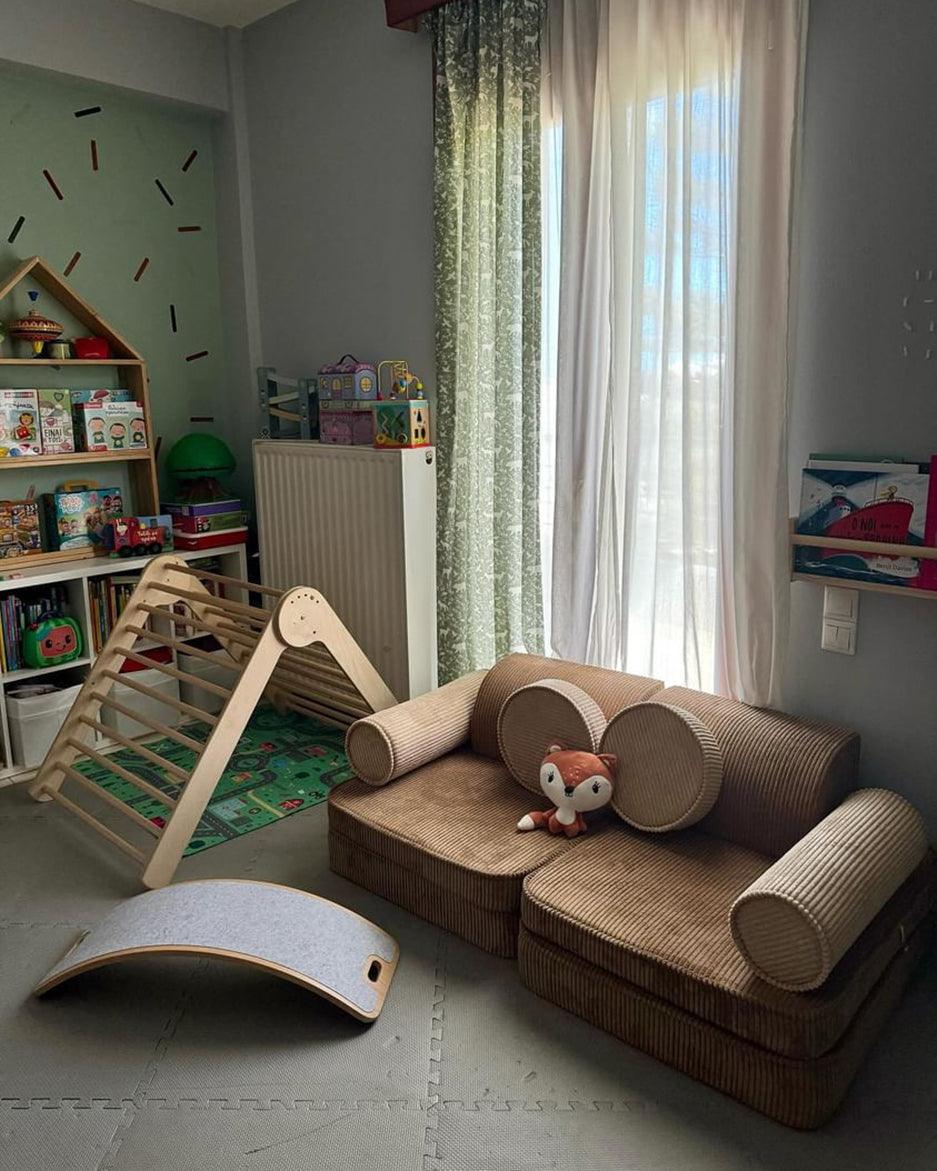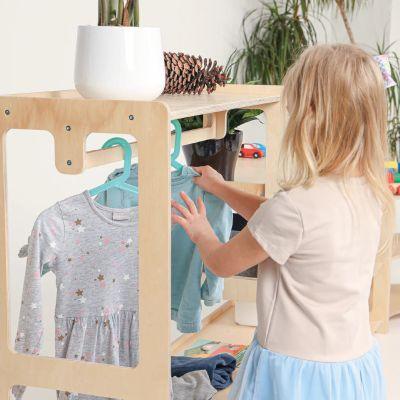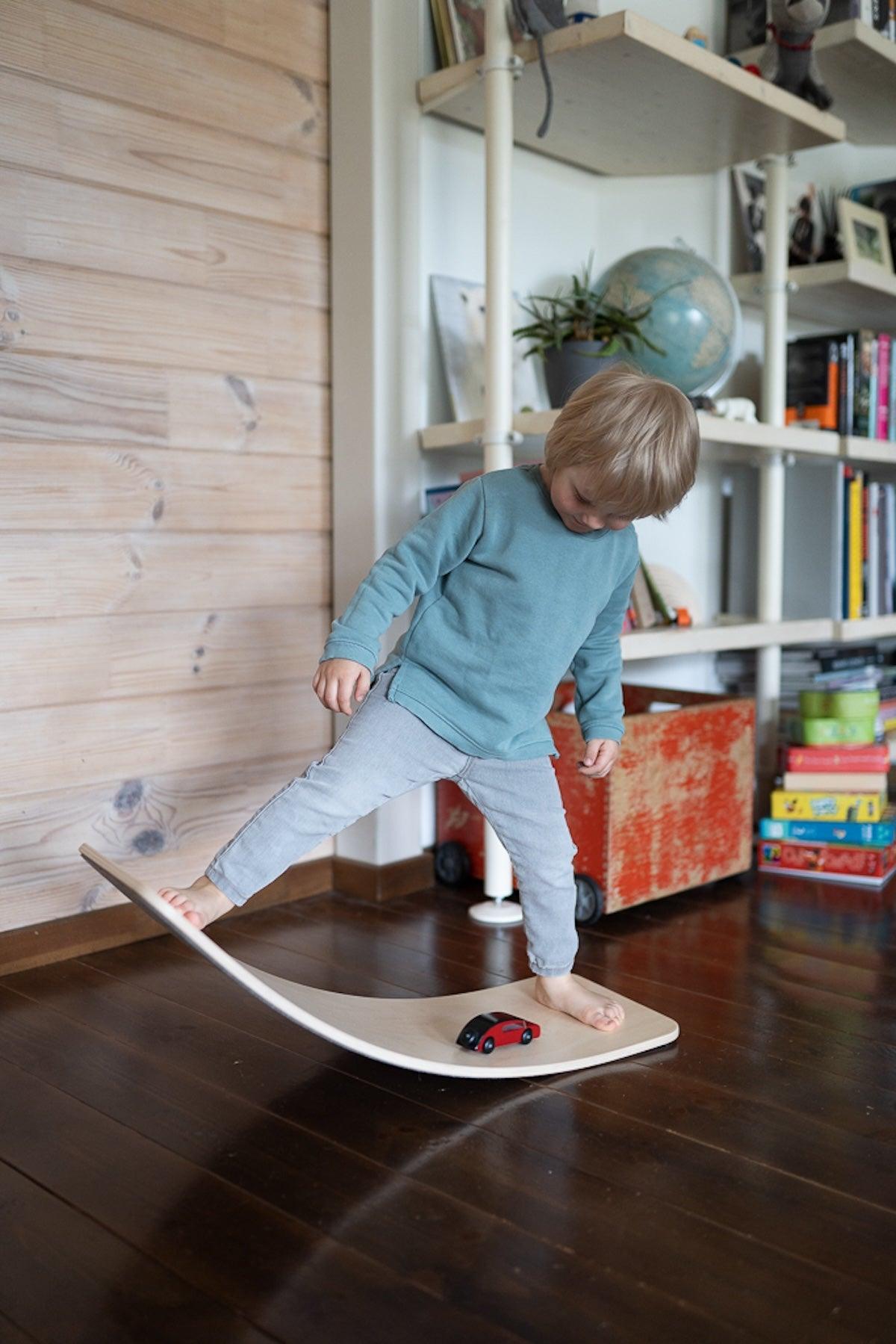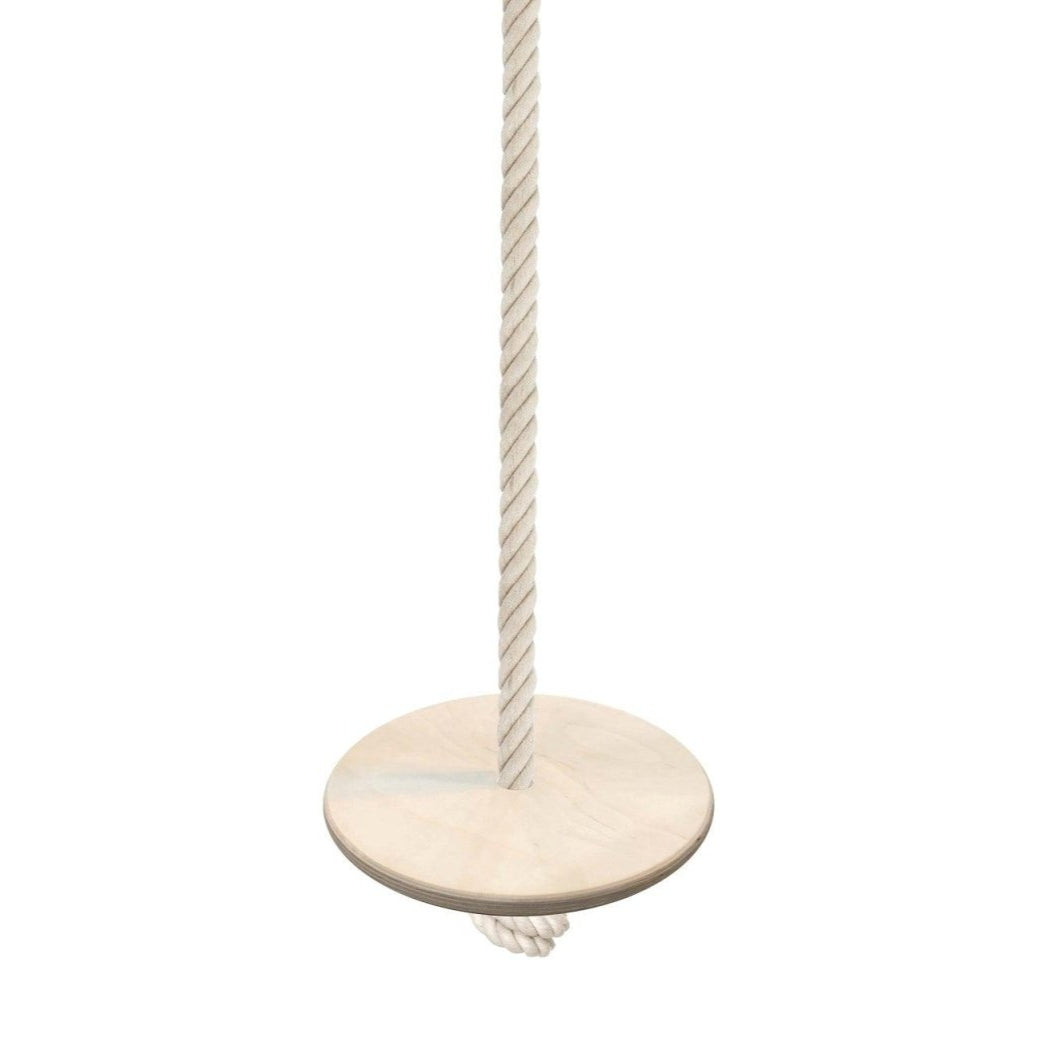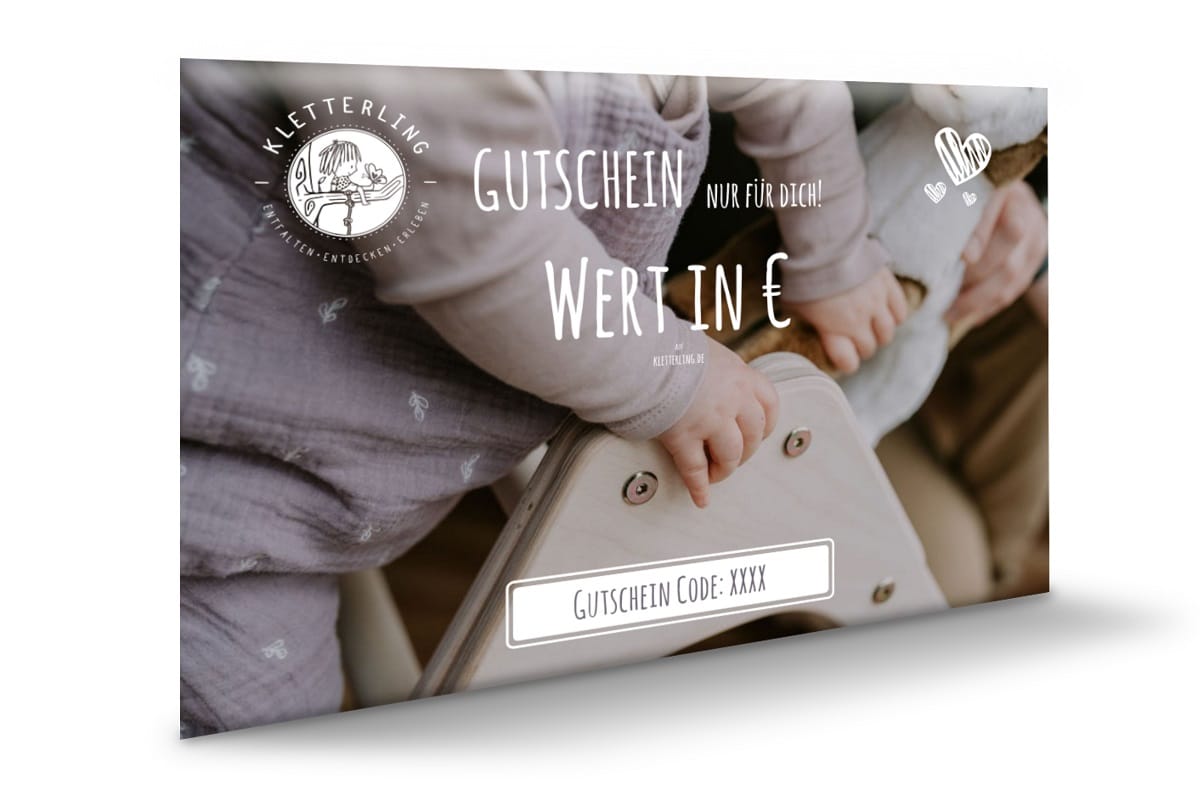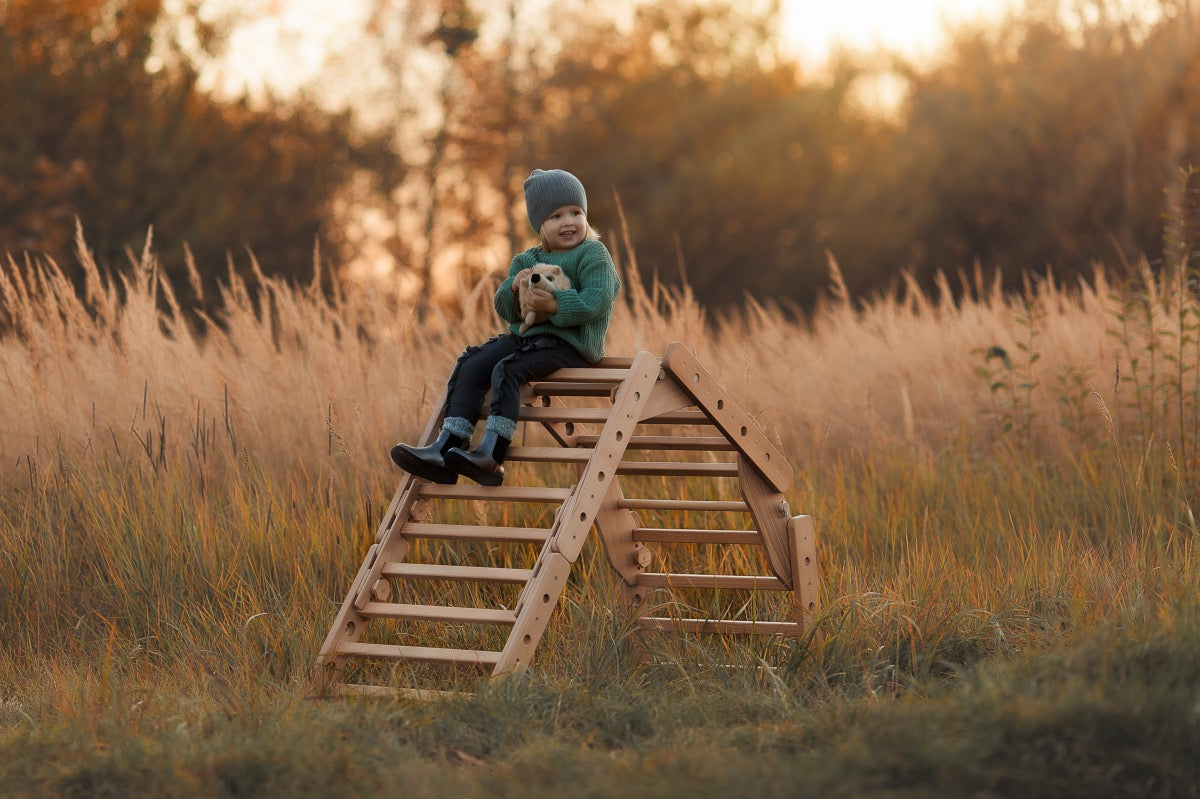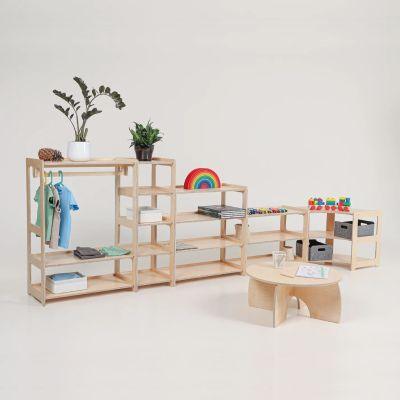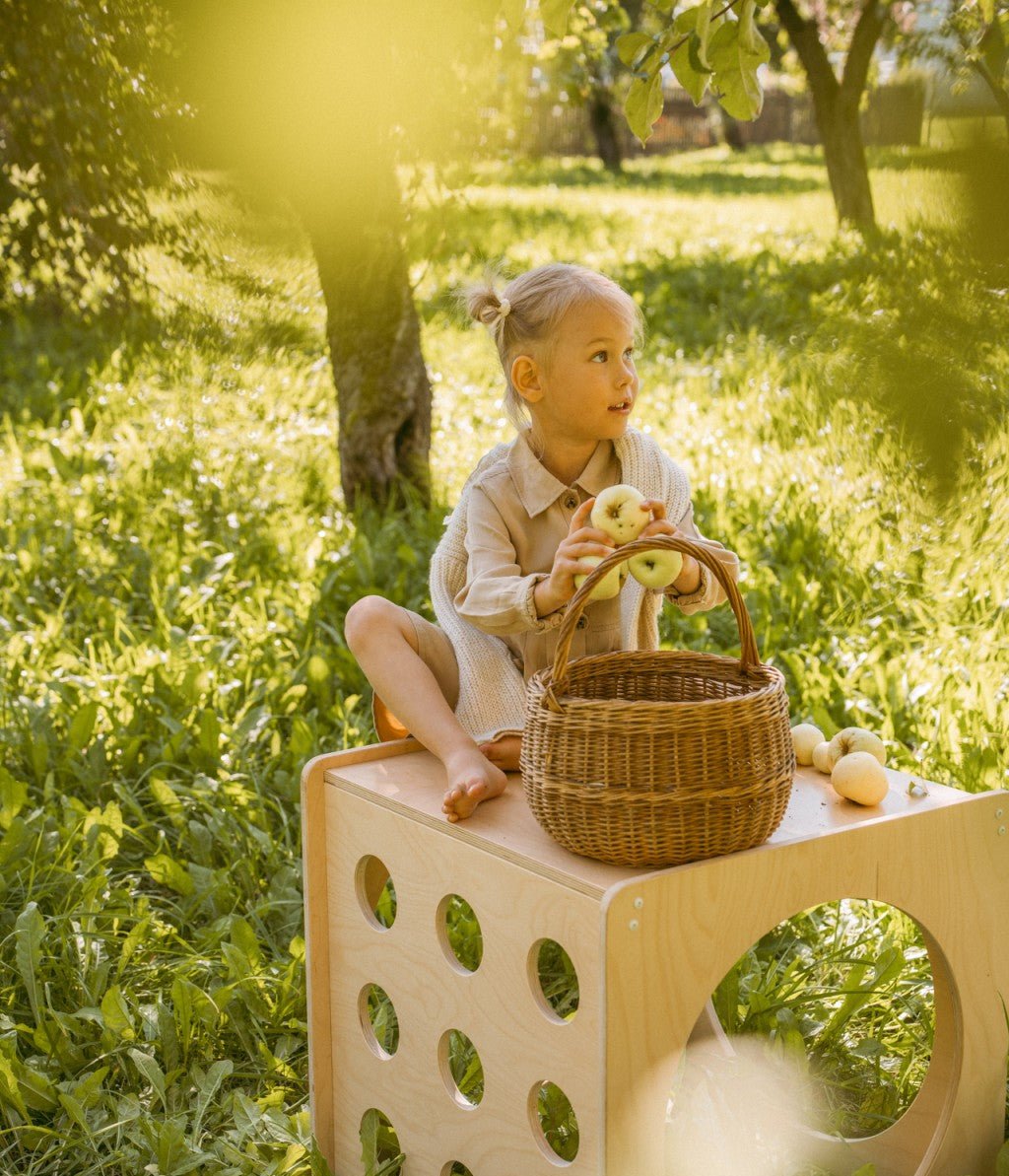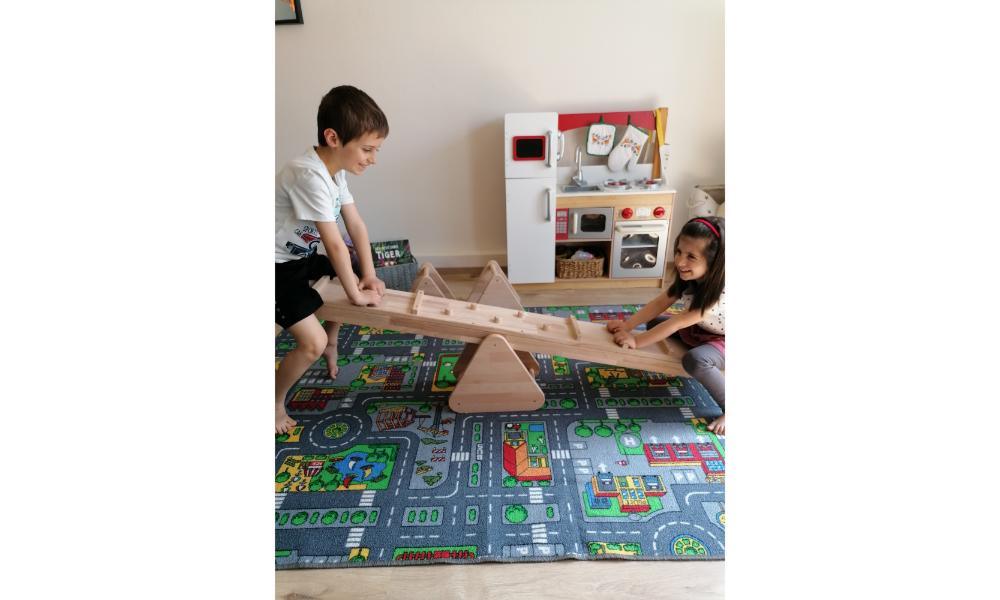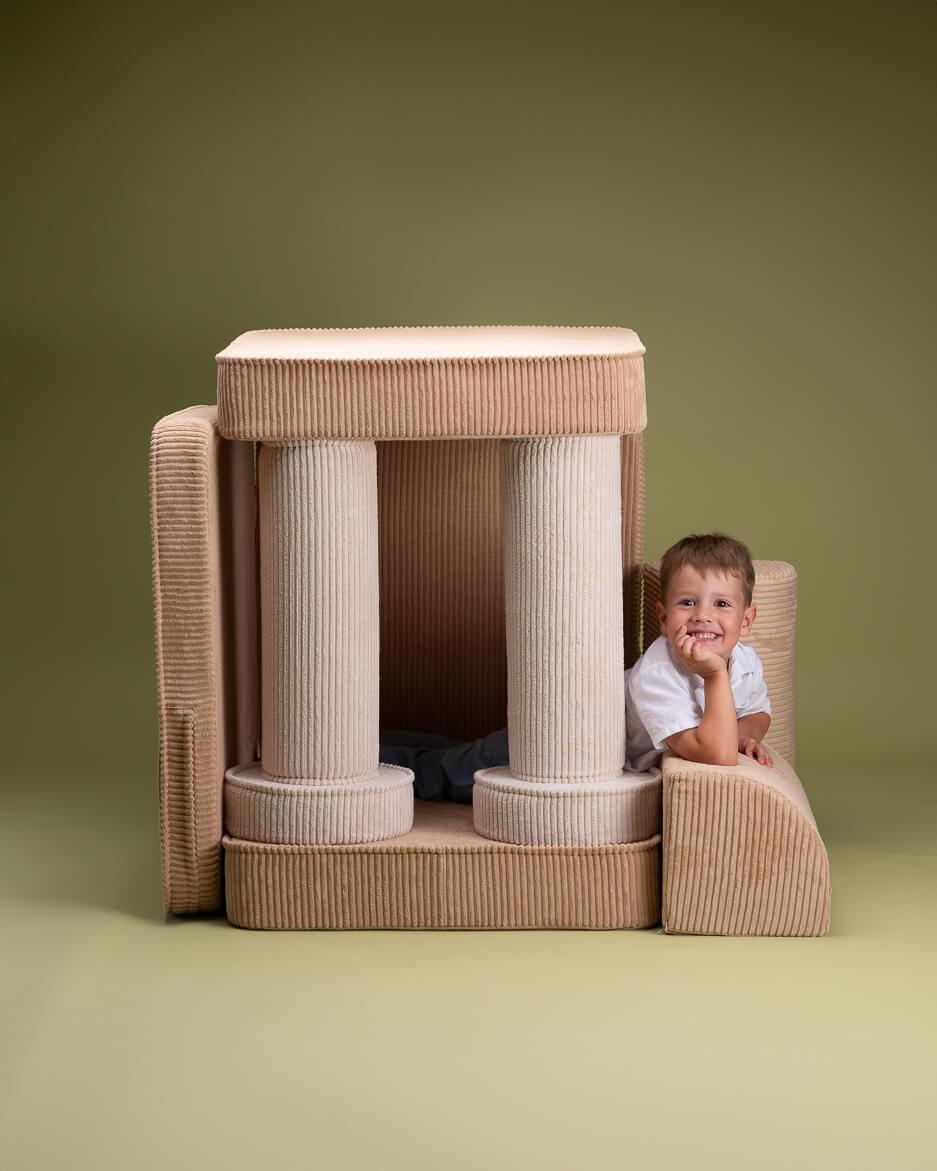Sort by:
19 products
19 products
This baby swing is the perfect addition to any garden or nursery. Ideal for babies and toddlers aged 12 months to 3 years, this wooden swing provides a comfortable, secure seat for hours of fun and entertainment. It's not just about keeping your child entertained - this baby swing also promotes physical development by improving balance, coordination and spatial awareness. Whether you set it up as a tree swing in your garden or as part of an indoor play area, this baby swing is sure to become a favourite part of your child's early years. Adjustable rope with a distance of 1.7 m to 2.6 m.
This classic wooden swing is handcrafted from high-quality birch wood and a durable nylon rope and treated with a child-safe, water-repellent hydro-oil - safe and environmentally friendly. It is perfect as an outdoor swing set or as a tree swing. The baby swing is lightweight and easy to assemble. It has been designed for comfort and fun to ensure stability and safety. Although the swing is perfect for outdoor use, we recommend storing it indoors when not in use to preserve its quality. And don't forget to never leave your child unattended while they are playing.
Age recommendation: Perfect for children aged 12 months to 3 years.
Capacity: Maximum weight: 80 kg (160 lbs) Weight: 4.3 kg (8.6 lbs)
Height: max. 2.60 m (8.5 ft), min. 1.7 m (5.6 ft)
Dimensions: 38 x 33 x 37 cm (15 x 13 x 14.5 inches)
Rope length: 4 metres (13.1 ft) Rope: 10 mm, polypropylene
Included in delivery: Wooden swing, two ropes, two wooden slings
The classic wooden swing is enjoyed in every direction. Let your imagination run wild as your child experiences exciting adventures, flies with the birds, sails across the ocean or floats through the trees! While playing, children develop important skills such as core strength, balance, coordination, spatial awareness and self-confidence. Adjustable rope with a distance of 1.7 m to 2.6 m.
This classic wooden swing is handcrafted from high-quality birch wood and a durable nylon rope and treated with a child-safe, water-repellent hydro-oil that is safe and environmentally friendly. It is perfect as an outdoor swing set or as a tree swing. The wooden children's swing is lightweight and easy to assemble. It has been designed for comfort and fun to ensure stability and safety. Although the swing is perfect for outdoor use, we recommend storing it indoors when not in use to preserve its quality. And don't forget to never leave your child unattended while they are playing.
Age recommendation: Perfect for children aged 3 and over.
Capacity: Maximum weight 80 kg (160 lbs) Weight: 1.5 kg (3.3 lbs)
Height: max. 2.60 m (8.5 ft), min. 1.7 m (5.6 ft)
Dimensions: 20 x 46 cm (7.9 x 18.1 inches) Rope length: 4 metres (13.1 ft) Rope: 10mm, polypropylene
Included in delivery: Wooden swing, two ropes, two wooden slings


Baby Jumper | ab 5 Monaten bis ca. 5 Jahre | Die ersten Schritte springen
From €129,00
Unit price perBaby Jumper | ab 5 Monaten bis ca. 5 Jahre | Die ersten Schritte springen
From €129,00
Unit price perEntdecke den Baby Jumper – das erste Trainingsgerät für dein Kind! Mit diesem vielseitigen Bungee-Jumper ermöglichst du deinem Baby von Anfang an aktive Bewegung, spielerische Entwicklung und jede Menge Freude. Geeignet für Kinder ab 5 Monaten bis ca. 5 Jahre, wächst der Jumper flexibel mit und bietet viele Einsatzmöglichkeiten – egal ob zu Hause, im Türrahmen, am Spielplatz oder an einer stabilen Sprossenwand.
Vielseitig & mitwachsend: 4 Nutzungsmöglichkeiten
1. Jumper:
Für Kinder von 5 Monaten bis 2 Jahren (bis 12 kg). Der Klassiker zum Springen und Hüpfen – einfach an einem Punkt aufgehängt.
2. Schaukel:
Ab 5 Monaten bis 2 Jahre (bis 20 kg). Befestigung an zwei Punkten – für sanftes Schaukeln und entspanntes Hin- und Herschwingen.
3. Trapez:
Von 2 bis 5 Jahren (bis 20 kg). Hier wird der Jumper zum spannenden Trapez – ideal für kleine Akrobaten.
4. Lauflernhilfe:
Bereits ab 5 Monaten geeignet. Unterstützt die ersten Gehversuche und sorgt für Sicherheit und Selbstvertrauen.
Förderung der Entwicklung – mit Spaß und Sicherheit
• Motorik & Koordination:
Der Jumper fördert die Koordination, stärkt die Muskulatur und trainiert den Gleichgewichtssinn.
• Vestibuläre Stimulation:
Das Springen und Schwingen trainiert das Gleichgewicht und das Körpergefühl – wichtige Grundlagen für spätere Sportarten wie Radfahren, Skifahren oder Inlineskaten.
• Entlastung für Eltern:
Während dein Baby glücklich springt, kannst du kurz entspannen und zusehen, wie sich dein Kind begeistert bewegt.
• Therapeutischer Nutzen:
Unterstützt bei der Behandlung von vermindertem Muskeltonus und der Rehabilitation nach Verletzungen.
Durchdachtes Design & hochwertige Materialien
• Ergonomischer Sitz:
Der Sitz besteht aus weicher Baumwolle mit angenehmem Futter – für höchsten Komfort und sicheren Halt.
• Innovative Federung:
Die Kombination aus Feder und elastischen Gummiseilen ermöglicht eine individuell einstellbare Sprungkraft – perfekt an das Gewicht deines Kindes anpassbar.
• Sichere Fixierung:
Fester Halt durch einen verstellbaren, stabilen Rückenbereich. Alle Materialien sind umweltfreundlich und geprüft.
• Hergestellt in der Ukraine aus hochwertigen, lokalen Materialien.
Wichtige Hinweise zur Nutzung
• Die empfohlene Nutzungsdauer beträgt max. 20–30 Minuten, 2x täglich.
• Nur unter Aufsicht verwenden und auf sichere Befestigung achten.
• Die richtige Größe richtet sich nach dem Taillenumfang deines Kindes. Im Zweifel lieber die größere Größe wählen.
Warum ein Baby Jumper?
✔️ Fördert die körperliche Entwicklung und Koordination
✔️ Sorgt für Freude und Bewegung im Alltag
✔️ Unterstützt die Entwicklung des Gleichgewichtssinns
✔️ Hilft bei überschüssiger Energie und verbessert Schlaf & Appetit
✔️ Ideale Vorbereitung auf viele Sportarten
Gönn deinem Kind die Freude am Springen und Entdecken – mit dem Baby Jumper für gesunde Entwicklung und strahlende Kinderaugen!
Hinweis: Für maximale Sicherheit immer die Befestigung und Gurte kontrollieren. Der Jumper ist kein Ersatz für elterliche Aufsicht.
Jetzt bestellen und die ersten sportlichen Abenteuer deines Babys begleiten!
The classic wooden swing is enjoyed in every direction. Let your imagination run wild as your child experiences exciting adventures, flies with the birds, sails across the ocean or floats through the trees! While playing, children develop important skills such as core strength, balance, coordination, spatial awareness and self-confidence. Adjustable rope with a distance of 1.7 m to 2.6 m.
This classic wooden swing is handcrafted from high-quality birch wood and a durable nylon rope and treated with a child-safe, water-repellent hydro-oil that is safe and environmentally friendly. It is perfect as an outdoor swing set or as a tree swing. The wooden children's swing is lightweight and easy to assemble. It has been designed for comfort and fun to ensure stability and safety. Although the swing is perfect for outdoor use, we recommend storing it indoors when not in use to preserve its quality. And don't forget to never leave your child unattended while they are playing.
Age recommendation: Perfect for children aged 3 and over.
Capacity: Maximum weight 80 kg (160 lbs) Weight: 1.5 kg (3.3 lbs)
Height: max. 2.60 m (8.5 ft), min. 1.7 m (5.6 ft)
Dimensions: 20 x 46 cm (7.9 x 18.1 inches) Rope length: 4 metres (13.1 ft) Rope: 10mm, polypropylene
Included in delivery: Wooden swing, two ropes, two wooden slings
Natural wooden disc swing can be swung in all directions - swinging up, turning, climbing or simply pushing and pulling. Let your imagination run wild as your child experiences exciting adventures, flies with the birds, sails across the ocean or floats through the trees! While playing, children develop important skills such as core strength, balance, coordination, spatial awareness and self-confidence. Adjustable rope with a distance of 1.3 m to 2.3 m. Handcrafted from high quality birch wood and durable nylon rope and fitted with a child-safe, waterproof hydro-oil, this disc swing is both safe and environmentally friendly. It is the perfect swing set for outdoor or tree swing setups. The disc swing for children is lightweight and easy to assemble. It has been designed for comfort and fun to ensure stability and safety. Although it is a perfect outdoor swing
We recommend storing it indoors when not in use to preserve its quality. And remember: never leave your child unattended while they are playing.
Age recommendation: Perfect for children aged 3 and over.
Capacity: Maximum 80 kg (160 lbs) Weight: 1.2 kg (2.4 lbs)
Height: max. 2.3 m (7.5 ft), min. 1.3 m (4.3 ft)
Dimensions: 34 cm (13. 4 in) Rope length: 4 metres (13.1 ft) Rope: ø 10 mm, polypropylene
Included: wooden disc, 4 m rope, wooden lock
Add this disc swing to your collection and watch your child's adventures reach new heights!
Give your child the joy of outdoor play with the KateHaa triangular rope ladder, a beautifully designed wooden swing for children. This versatile swing promotes balance, coordination and physical movement while improving gross motor skills and boosting self-confidence. Perfect for indoor and outdoor use, the swing toy is lightweight and easy to assemble, making it ideal for the garden, park or playroom. Adjustable wooden bar spacing from 25 cm to 40 cm.
The triangular rope ladder for children aged between 3 and 12 years is handmade from high-quality birch wood and is the perfect tool for developing gross motor skills. With sturdy wooden rope slings and durable ropes, this tree swing offers safety and stability. Treated with a child-safe, waterproof hydro-fluid, it is safe for children and ideal for use as an outdoor swing. We recommend storing it indoors when not in use to preserve its quality.
Watch your child have endless adventures with this amazing climbing structure. The design allows them to swing, spin and perform acrobatic moves for hours of fun. Make sure your child is always supervised when playing on children's swings.
Age recommendation: Ideal for children aged 3 years and over.
Capacity: Maximum weight: 80 kg (160 lbs)
Weight: 4.0 kg (8.8 lbs) / 5.9 kg (13.0 lbs)
Height: 2.10 m (6.9 ft)
Dimensions: 76 cm long wooden poles, inner diameter 48 cm
Rope length: 4 metres (13.1 ft) / 4.5 metres (14.8 ft) Rope: ø 10mm polypropylene
Included: wooden poles, three ropes.
Enhance your child's playtime with the KateHaa Triangle Ladder Rope, the perfect outdoor swing set that combines fun, safety and durability!
This baby swing is the perfect addition to any garden or nursery. Ideal for babies and toddlers aged 12 months to 3 years, this wooden swing provides a comfortable, secure seat for hours of fun and entertainment. It's not just about keeping your child entertained - this baby swing also promotes physical development by improving balance, coordination and spatial awareness. Whether you set it up as a tree swing in your garden or as part of an indoor play area, this baby swing is sure to become a favourite part of your child's early years. Adjustable rope with a distance of 1.7 m to 2.6 m.
This classic wooden swing is handcrafted from high-quality birch wood and a durable nylon rope and treated with a child-safe, water-repellent hydro-oil - safe and environmentally friendly. It is perfect as an outdoor swing set or as a tree swing. The baby swing is lightweight and easy to assemble. It has been designed for comfort and fun to ensure stability and safety. Although the swing is perfect for outdoor use, we recommend storing it indoors when not in use to preserve its quality. And don't forget to never leave your child unattended while they are playing.
Age recommendation: Perfect for children aged 12 months to 3 years.
Capacity: Maximum weight: 80 kg (160 lbs) Weight: 4.3 kg (8.6 lbs)
Height: max. 2.60 m (8.5 ft), min. 1.7 m (5.6 ft)
Dimensions: 38 x 33 x 37 cm (15 x 13 x 14.5 inches)
Rope length: 4 metres (13.1 ft) Rope: 10 mm, polypropylene
Included in delivery: Wooden swing, two ropes, two wooden slings


Gymnastic rings - rings made of wood and natural rope perfect for the wall bars - set of 2
€49,00
Unit price perGymnastic rings - rings made of wood and natural rope perfect for the wall bars - set of 2
€49,00
Unit price perOur gymnastic ringsÖÖturnthe children's room, playground or wall bars into a jungle and every climber becomes a swinging monkey. These beautiful, handmade rings can be easily attached anywhere that swings can be attached. But above all, of course, on our wall bars Giraffenling. Simply knot the thick natural rope. The rope is really soft and woven from natural cotton and is nice and thick, making it easy to grip, so you can simply swing the rope over a beam.
Features: can be hung on our wall bars and on any beam soft natural cotton rope
Can be combined with: Giraffenling wall bars
Age recommendation: suitable from 2 years
Material: Untreated birch plywood Cotton rope
Dimensions: Rings each approx. 19.5 cm in diameter, rope approx. 115 cm long
turns the children's room into a jungle and every climber into a swinging monkey. This beautiful, handmade disc swing can be easily attached anywhere that swings can be attached. But above all, of course, on our Giraffenling wall bars. The rope is really soft and woven from natural cotton and is nice and thick, making it easy to grip. At the top end, the rope has a metal ring to attach it to existing swing hooks. Of course, you can also simply swing the rope over a beam.
Features: can be attached to our wall bars and to any beam soft natural cotton rope
Can be combined with: Giraffenling wall bars
Age recommendation: suitable from 2 years
Material: untreated birch plywood cotton rope
Dimensions: plate diameter approx. 35cm, rope approx. 115cm long


Therapy swing: Sensory swing for children and adults with and without disabilities
From €230,00
Unit price perTherapy swing: Sensory swing for children and adults with and without disabilities
From €230,00
Unit price perTherapy swing - Sensory swing for children and adults with special needs
| Company/manufacturer | |
|---|---|
| High-quality therapeutic products | |
| Material | |
| Soft, size-adjustable fit, stretchable ropes | |
| Suitability | |
| People with cerebral palsy, muscular dystrophy, partial paralysis, Asperger's syndrome, MS | |
| Certificates | |
| EN 71-1:2014 + A1:2018, EN 71-2:2020, EN 71-8:2018 | |
| Special functions | Light, ecological strain on the muscular system, improves blood circulation and strengthens the joints |
The therapy swing is a unique simulator that has been specially developed for people with special needs. It helps to improve physical condition and enable sporting activities, even if excessive physical exertion is contraindicated. Thanks to its ergonomic design and stretchable ropes, this swing provides a gentle and ecological load on the muscular system, improves blood circulation and lymphatic flow, strengthens the joints in the knees and hips and supports recovery after injuries
.The therapy swing offers two opposing effects: By gently rocking, it has a relaxing effect and relieves the joints and muscles. When used actively, it provides a physical load that can help to strengthen the muscles.
Who is the therapy swing suitable for?
- People with cerebral palsy
- Overweight people
- People with musculoskeletal difficulties, partial paralysis, muscular dystrophy, multiple sclerosis, paralysis (partial), Asperger's
- To support recovery after injuries
Available sets
Set S
- Adjustable seat for hip circumference: 40-80 cm
- 4 stretchable ropes, diameter: 8 mm, length: 240 cm
- 2 adjustable rucksack straps
- 2 installation points
- Load weight: 25-40 kg
Set M
- Adjustable seat for hip circumference: 85-100 cm
- 4 stretchable ropes, diameter: 10 mm, length: 240 cm
- 2 adjustable rucksack straps
- 2 installation points
- Load weight: 50-60 kg
Set L
- Adjustable seat for hip circumference: 100-125 cm
- 4 stretchable ropes, diameter: 12 mm, length: 240 cm
- 2 adjustable rucksack straps
- 2 installation points
- Load weight: 70-90 kg
Set XL
- Adjustable seat for hip circumference: 120-140 cm
- 8 stretchable ropes, diameter: 8 mm, length: 240 cm
- 2 adjustable rucksack straps
- 2 installation points
- Load weight: 100-130 kg
| S | M | L | ||
|---|---|---|---|---|
| XL | ||||
| Soft fit | Hip 40-80cm | Hip 85-100cm | Hip 100-125cm | |
| Hip 120-140cm | ||||
| Expansion rope | : 8mm | 10mm | 12mm | |
| 8x diameter: 8mm | ||||
| Backpack straps | 2 | 2 | 2 | |
| 2 | ||||
| Number of fixing points | 2 | 2 | 2 | |
| 2 | ||||
| Carabiner | 6 | 6 | 6 | |
| 6 | ||||
| Load weight | 25-40kg | 50-60kg | 70-90kg | 100-130kg |
Attention: The hooks for installation in the ceiling are not included in the scope of delivery. These can easily be purchased at any DIY store at a reasonable price to ensure suitability for your ceiling material.
Attention2: As the delivery is made from Ukraine, customs duties are due, which you bear and amount to approx. 30€;. In the event that the parcel is returned because the recipient could not be found and the parcel was not collected from where it was deposited, fees will also be charged as the parcel will then be returned to Ukraine.
Give your child the joy of outdoor play with the KateHaa triangular rope ladder, a beautifully designed wooden swing for children. This versatile swing promotes balance, coordination and physical movement while improving gross motor skills and boosting self-confidence. Perfect for indoor and outdoor use, the swing toy is lightweight and easy to assemble, making it ideal for the garden, park or playroom.
Adjustable wooden bar spacing from 25 cm to 40 cm.
Handmade from high-quality birch wood, the triangular rope ladder for children aged 3 to 12 is the perfect tool for developing gross motor skills. With sturdy wooden rope slings and durable ropes, this tree swing offers safety and stability. Treated with a child-safe, waterproof hydro-&-oil, it is safe for children and ideal for use as an outdoor swing. We recommend storing it indoors when not in use to preserve its quality.
Watch your child have endless adventures with this amazing climbing structure. The design allows them to swing, spin and perform acrobatic moves for hours of fun.
Make sure your child is always supervised when playing on children's swings.
Age recommendation: Ideal for children aged 3 years and older.
Capacity: Maximum weight: 80 kg (160 lbs)
Weight: 4.0 kg (8.8 lbs) / 5.9 kg (13.0 lbs)
Height: 2.10 m (6.9 ft)
Dimensions: 76 cm long wooden poles, inner diameter 48 cm
Rope length: 4 metres (13.1 ft) / 4.5 metres (14.8 ft) Rope: ø 10 mm polypropylene
Included: wooden poles, three ropes.
Enhance your child's playtime with the KateHaa triangular rope ladder, the perfect outdoor swing set that combines fun, safety and durability!
Give your child the joy of outdoor play with the KateHaa triangular rope ladder, a beautifully designed wooden swing for children. This versatile swing promotes balance, coordination and physical movement while improving gross motor skills and boosting self-confidence. Perfect for indoor and outdoor use, the swing toy is lightweight and easy to assemble, making it ideal for the garden, park or playroom. Adjustable wooden bar spacing from 25 cm to 40 cm.
The triangular rope ladder for children aged between 3 and 12 years is handmade from high-quality birch wood and is the perfect tool for developing gross motor skills. With sturdy wooden rope slings and durable ropes, this tree swing offers safety and stability. Treated with a child-safe, waterproof hydro-fluid, it is safe for children and ideal for use as an outdoor swing. We recommend storing it indoors when not in use to preserve its quality.
Watch your child have endless adventures with this amazing climbing structure. The design allows them to swing, spin and perform acrobatic moves for hours of fun. Make sure your child is always supervised when playing on children's swings.
Age recommendation: Ideal for children aged 3 years and over.
Capacity: Maximum weight: 80 kg (160 lbs)
Weight: 4.0 kg (8.8 lbs) / 5.9 kg (13.0 lbs)
Height: 2.10 m (6.9 ft)
Dimensions: 76 cm long wooden poles, inner diameter 48 cm
Rope length: 4 metres (13.1 ft) / 4.5 metres (14.8 ft) Rope: ø 10mm polypropylene
Included: wooden poles, three ropes.
Enhance your child's playtime with the KateHaa Triangle Ladder Rope, the perfect outdoor swing set that combines fun, safety and durability!
Natural wooden disc swing can be swung in all directions - swinging up, turning, climbing or simply pushing and pulling. Let your imagination run wild as your child experiences exciting adventures, flies with the birds, sails across the ocean or floats through the trees! While playing, children develop important skills such as core strength, balance, coordination, spatial awareness and self-confidence. Adjustable rope with a distance of 1.3 m to 2.3 m. Handcrafted from high quality birch wood and durable nylon rope and fitted with a child-safe, waterproof hydro-oil, this disc swing is both safe and environmentally friendly. It is the perfect swing set for outdoor or tree swing setups. The disc swing for children is lightweight and easy to assemble. It has been designed for comfort and fun to ensure stability and safety. Although it is a perfect outdoor swing
We recommend storing it indoors when not in use to preserve its quality. And remember: never leave your child unattended while they are playing.
Age recommendation: Perfect for children aged 3 and over.
Capacity: Maximum 80 kg (160 lbs) Weight: 1.2 kg (2.4 lbs)
Height: max. 2.3 m (7.5 ft), min. 1.3 m (4.3 ft)
Dimensions: 34 cm (13. 4 in) Rope length: 4 metres (13.1 ft) Rope: ø 10 mm, polypropylene
Included: wooden disc, 4 m rope, wooden lock
Add this disc swing to your collection and watch your child's adventures reach new heights!
Give your child the joy of outdoor play with the KateHaa triangular rope ladder, a beautifully designed wooden swing for children. This versatile swing promotes balance, coordination and physical movement while improving gross motor skills and boosting self-confidence. Perfect for indoor and outdoor use, the swing toy is lightweight and easy to assemble, making it ideal for the garden, park or playroom. Adjustable wooden bar spacing from 25 cm to 40 cm.
The triangular rope ladder for children aged between 3 and 12 years is handmade from high-quality birch wood and is the perfect tool for developing gross motor skills. With sturdy wooden rope slings and durable ropes, this tree swing offers safety and stability. Treated with a child-safe, waterproof hydro-fluid, it is safe for children and ideal for use as an outdoor swing. We recommend storing it indoors when not in use to preserve its quality.
Watch your child have endless adventures with this amazing climbing structure. The design allows them to swing, spin and perform acrobatic moves for hours of fun. Make sure your child is always supervised when playing on children's swings.
Age recommendation: Ideal for children aged 3 years and over.
Capacity: Maximum weight: 80 kg (160 lbs)
Weight: 4.0 kg (8.8 lbs) / 5.9 kg (13.0 lbs)
Height: 2.10 m (6.9 ft)
Dimensions: 76 cm long wooden poles, inner diameter 48 cm
Rope length: 4 metres (13.1 ft) / 4.5 metres (14.8 ft) Rope: ø 10mm polypropylene
Included: wooden poles, three ropes.
Enhance your child's playtime with the KateHaa Triangle Ladder Rope, the perfect outdoor swing set that combines fun, safety and durability!


Dreieck- & Sprossenwandschaukel LOOPO SWING 2in1 | 180 kg belastbar | 2 Geräte in einem | Kletterdreieck & Schaukel für die Wand | wandelbar
€239,00
Unit price perDreieck- & Sprossenwandschaukel LOOPO SWING 2in1 | 180 kg belastbar | 2 Geräte in einem | Kletterdreieck & Schaukel für die Wand | wandelbar
€239,00
Unit price perKletterdreieck & Sprossenwand mit Schaukel LOOPO SWING | 180 kg belastbar | 2-in-1 Spielgerät ab 1 Jahr
Klettern oder Schaukeln? Warum nicht beides – mit einem Set, das sich ganz einfach verwandeln lässt.
Die Sprossenwandschaukel LOOPO ist ein kompaktes, wandelbares Spielgerät für Kinder ab 1 Jahr. Es bietet zwei Möglichkeiten in einem cleveren System: Als freistehendes Pikler-Dreieck eignet es sich ideal für erste Kletterversuche – befestigt an der Wand, wird es zur Schaukelstation im Montessori-Stil. Einfache Handhabung, sicheres Design und jede Menge Bewegung machen dieses Set zu einem beliebten Spielbegleiter für drinnen und draußen. Dieses modulare EMMA System kann unendlich erweitert werden.
Ideal für kleine Räume & große Spielfreude
Dank seiner kompakten Größe und der vielseitigen Nutzbarkeit passt das Set auch in kleinere Wohnbereiche. Es lädt Kinder dazu ein, sich aktiv zu bewegen, ihre Motorik zu fördern und gleichzeitig spielerisch Selbstvertrauen aufzubauen.
Produktdetails auf einen Blick
| Altersempfehlung | 1–6 Jahre |
| Belastbarkeit | bis 180 kg |
| Material | Massivholz Buche |
| Oberfläche | glatt geschliffen & geölt |
| Gesamtgewicht | ca. 9,1 kg |
| Aufbaumöglichkeiten | 2 |
| Pikler-Dreieck | H 46 cm × B 97 cm × T 60 cm |
| Schaukelstation (wandmontiert) | H 200 cm × B 60 cm × T 70 cm |
Packungsinhalt
- 2 × LOOPO-Paneele
- 2 × Verbindungsstück Winkel T2
- 2 × Wandhalterung W1
- 4 × Schrauben (35 mm)
- 2 × Stabilitäts-Metallstifte
- 1 × Holzstange mit Splinten
- 1 × Schaukel „Classic“
- 1 × Schlüssel
Aufbau & Anleitung
- 📄 Aufbauanleitung: im Lieferumfang enthalten (PDF)
Geprüft & zertifiziert
- EN 71-1:2014+A1:2018 – Sicherheit mechanischer Eigenschaften
- EN 71-8:2018 – Sicherheit aktiver Bewegungsspielzeuge
Pflege & Verwendung
Die Oberfläche ist mit einem natürlichen Öl behandelt und dadurch geschützt. Zur Reinigung reicht ein trockenes oder leicht feuchtes Tuch – bitte keine scharfen Reinigungsmittel oder scheuernden Schwämme verwenden. Um die Langlebigkeit zu erhalten, kann die geölte Oberfläche bei Bedarf mit geeignetem Pflegeöl aufgefrischt werden.
Nachhaltigkeit, Sicherheit & Qualität – dafür steht die LOOPO-Serie
Alle EMMA-Produkte werden aus massivem, geöltem Buchenholz gefertigt, das aus FSC-zertifizierter, europäischer Waldwirtschaft stammt. Produziert wird im Böhmischen Paradies in Tschechien – unter fairen Bedingungen, mit kurzen Lieferwegen und umweltfreundlicher Verpackung. Die Spielgeräte erfüllen die europäische Spielzeugnorm EN 71 und sind bis zu 200 kg belastbar – geprüft und geeignet für Kinder und Erwachsene. Zusätzlich bietet EMMA 2 Jahre Garantie – mit kostenfreier Verlängerung auf 5 Jahre bei Registrierung. Nachhaltig. Sicher. Fair.
Kletterdreieck - & Sprossenwandschaukel LOOPO SWING – für Kletterfreude mit Schwung.
Ideal für alle, die Bewegung lieben – platzsparend, vielseitig und kindgerecht.
Schaukel CLASSIC | 180 kg belastbar | ab 1 Jahr | klassisch & vielseitig
Klassisch, vielseitig, fördernd – die perfekte Ergänzung für aktives Spielen drinnen und draußen.
Die Schaukel Emma ist nicht nur ein Spielgerät, sondern ein effektives Trainingsmittel für Kinder. Sie fördert den Gleichgewichtssinn, die Koordination und aktiviert auf natürliche Weise die Tiefenmuskulatur – ganz nebenbei beim Schaukeln! Ob als Teil eines Loopo- oder Kletterling-Sets oder als eigenständige Schaukel im Garten oder Kinderzimmer – dieses Zubehör sorgt für jede Menge Bewegung und Spaß.
Zwei Anwendungsmöglichkeiten:
- Stabil & einsteigerfreundlich: mit Seitenteilen aus Holz, die zusätzliche Führung geben – ideal für kleinere Kinder.
- Herausfordernd & frei: ohne Seitenteile, mit direkter Seilbefestigung an der Sitzfläche – für mehr Körperspannung und Kontrolle.
Produktdetails auf einen Blick
| Altersempfehlung | ab ca. 1 Jahr |
| Belastbarkeit | bis 180 kg |
| Maße der Sitzfläche | Länge: 380 mm / Breite: 200 mm |
| Seillänge | ca. 2000 mm |
| Material | 100 % Buchensperrholz |
| Nutzung | geknotet, an Deckenhaken oder an Klettersets montierbar |
Packungsinhalt
- 1 × Schaukel CLASSIC (Sitzfläche + 2 Seitenteile)
- 2 × Seil (je ca. 2 m)
- Befestigungsmaterial
Die Lieferung erfolgt zerlegt.
Aufbau & Sicherheit
- 📄 Aufbauanleitung: im Lieferumfang enthalten
- 🔒 Wichtig: Bitte prüfe die Seile mindestens alle 3 Monate an Knoten und Kontaktstellen. Bei sichtbaren Abnutzungen bitte sofort austauschen.
Garantie
- 2 Jahre gesetzliche Gewährleistung
- 5 Jahre Garantie bei Produktregistrierung
Schaukel Emma – schaukeln, stärken, wachsen.
Ein Zubehör, das Freude macht – und spielerisch die Entwicklung unterstützt.
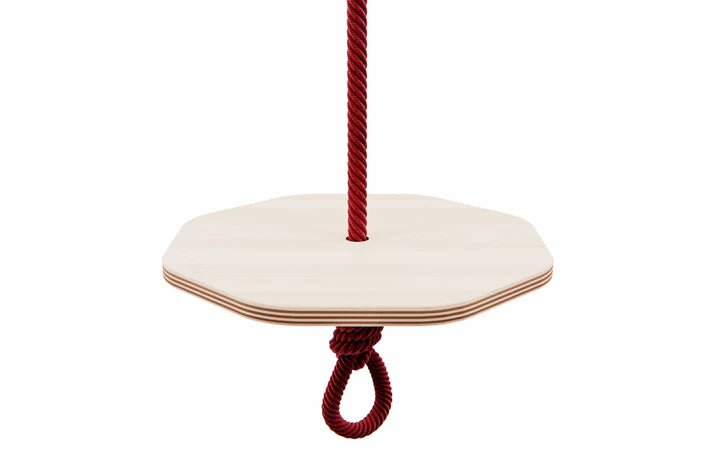
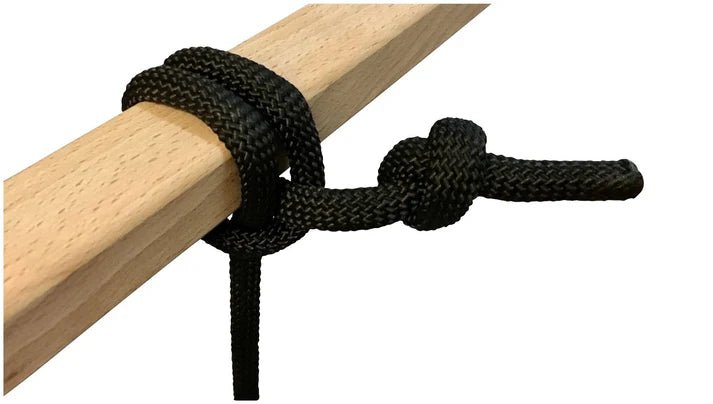
Tellerschaukel POMA | 180 kg belastbar | Balancetraining für Kinder ab 3 Jahren
€35,00
Unit price perTellerschaukel POMA | 180 kg belastbar | Balancetraining für Kinder ab 3 Jahren
€35,00
Unit price perTellerschaukel von POMA | 180 kg belastbar | ab 3 Jahren | ø 20 cm
Leicht, dynamisch, effektiv – die Schaukel für Balance, Körpergefühl und jede Menge Spaß.
Die Tellerschaukel POMA ist eine kompakte und besonders bewegungsaktive Variante des Schaukelns. Durch ihre freihängende Konstruktion wird das tiefenstabilisierende Muskelkorsett des Kindes aktiviert – ganz spielerisch beim Schwingen. Das perfekte Zubehör für Kinder, die sich gerne bewegen – ob drinnen, draußen.
Ideal für Balance & Körperspannung
Beim Schaukeln mit der Tellerschaukel Emma wird nicht nur die Koordination geschult, sondern auch das Gleichgewicht nachhaltig verbessert. Die reduzierte Sitzfläche fördert eine aufrechte Haltung und fordert das Kind, die Bewegung aktiv zu steuern – ein großartiges Training für Konzentration und Körperkontrolle.
Fördert wichtige Fähigkeiten
• Verbesserung von Gleichgewicht, Koordination und Beweglichkeit
• Stärkung der Muskulatur und Erwerb motorischer Fähigkeiten
• Förderung von Selbstvertrauen und kognitiver Entwicklung
• Sorgt für Ausgeglichenheit, guten Schlaf und beste Laune
Produktdetails auf einen Blick
| Altersempfehlung | ab 3 Jahren |
| Belastbarkeit | bis 180 kg |
| Sitzdurchmesser | 200 mm |
| Seillänge | ca. 2000 mm |
| Material | 100 % Buchensperrholz |
| Gewicht | ca. 0,36 kg |
| Montage | einfach & schnell – auch ohne Spielset nutzbar |
| Nutzung | für Loopo/Kletterling-Sets oder freihängend an Balken, Deckenhaken oder Klettergerüsten |
Packungsinhalt
- 1 × Tellerschaukel POMA (runder Sitz)
- 1 × Seil (ca. 2 m Länge)
Sicherheitshinweis
Wichtig: Bitte überprüfe das Seil mindestens alle 3 Monate – insbesondere an Knoten oder Kontaktstellen mit Holz. Bei sichtbaren Abnutzungen oder Rissen muss das Seil sofort ersetzt werden.
Garantie
- 2 Jahre gesetzliche Gewährleistung
- 5 Jahre Garantie bei Produktregistrierung
Tellerschaukel Emma – klein im Format, groß in der Wirkung.
Für kleine Abenteurer, die beim Spielen Balance und Körpergefühl stärken möchten.
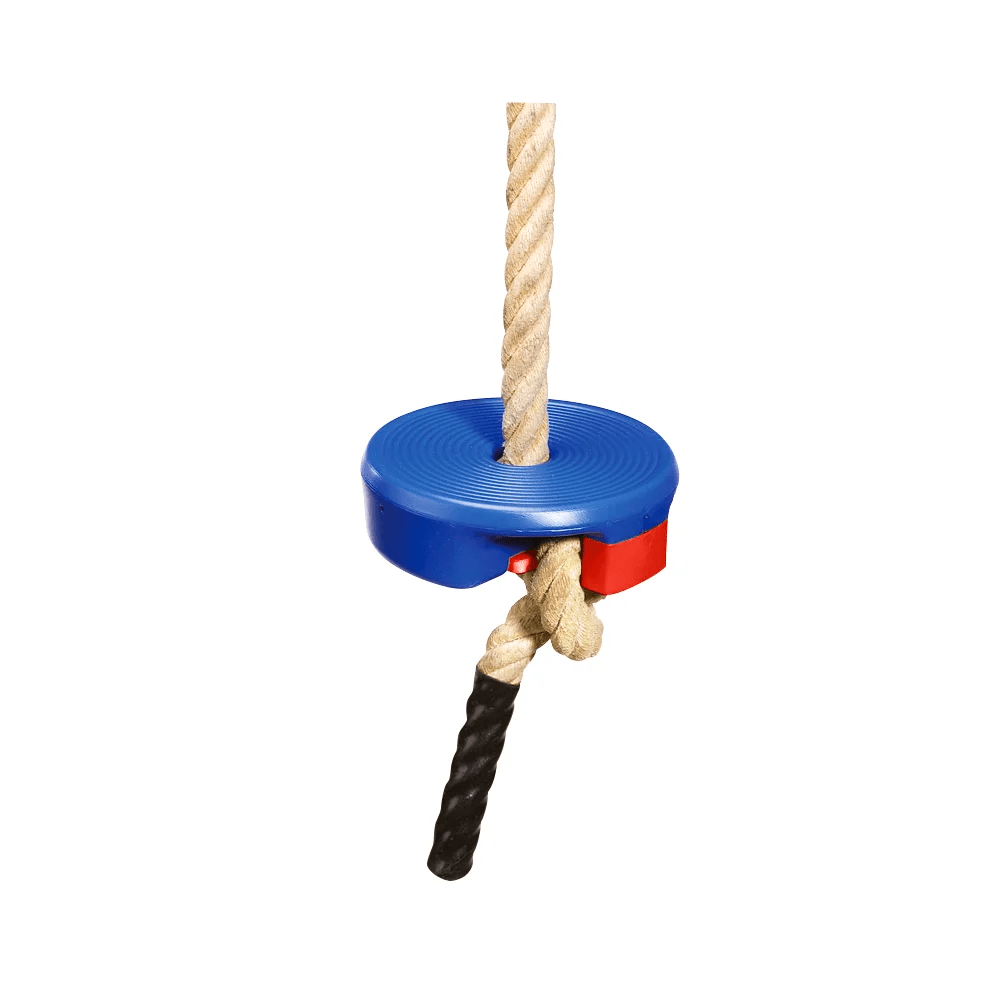
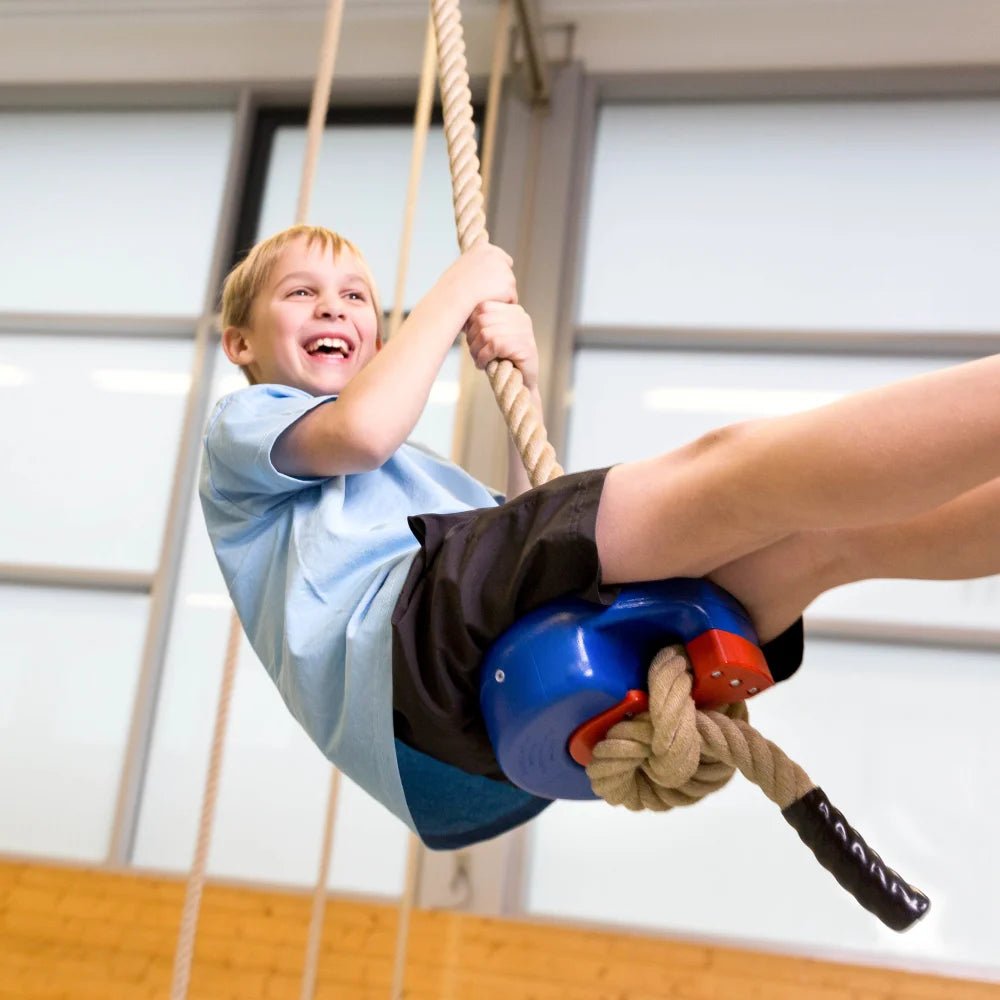
Schaukelsitz RUNDOLINO | Schaukeln, Schwingen, Drehen | bis 90 kg
€45,99
Unit price perSchaukelsitz RUNDOLINO | Schaukeln, Schwingen, Drehen | bis 90 kg
€45,99
Unit price perBewegung mit Leichtigkeit – der RUNDOLINO Schaukelsitz für kleine & große Wirbelwinde
Ob wildes Schwingen, sanftes Drehen oder lustiges Kreisen – der RUNDOLINO bringt Schwung in jedes Kinderzimmer, auf den Spielplatz oder in die Turnhalle. Einfach am Seil befestigen und los geht’s!
Für Kinder und Erwachsene, die das Gefühl von Fliegen lieben – und dabei spielerisch Gleichgewicht und Koordination fördern. Ein fröhlicher Schaukelspaß, der lange Freude macht.
Highlights auf einen Blick
- Für alle Altersgruppen – bis 90 kg belastbar
- Einfach an Klettertauen (Ø bis 35 mm) befestigen
- Indoor & Outdoor geeignet – wetterfester Kunststoff
- Montage ohne Werkzeug – kinderleicht!
- Aus einem Guss gefertigt – besonders stabil & leicht
- TÜV Rheinland zertifiziert
- Made in Germany – langlebig & robust
Produktdetails
| Produktgröße: | Ø 22 cm, Höhe ca. 7 cm |
| Gewicht: | ca. 0,5 kg |
| Material: | Hochwertiger Kunststoff (ein Guss, Hohlkörper) |
| Belastbarkeit: | bis 90 kg |
| Farbe: | Gelb |
| Tauöffnung: | Ø 39 mm – passend für Seile bis Ø 35 mm |
| Einsatzorte: | Indoor & Outdoor – Schule, Kita, Zuhause |
| Lieferung: | Ohne Tau |
| Zertifizierung: | TÜV Rheinland geprüft |
| Herstellung: | Made in Germany |
Handhabung & Lagerung
Der RUNDOLINO lässt sich werkzeuglos am Klettertau befestigen. Nach dem Spielen einfach stapeln oder an einem Turnstab verstauen – ideal für Zuhause, Sporthalle oder Kita.
Sicherheit
Nur unter Aufsicht von Erwachsenen verwenden. Vor dem Schaukeln die Befestigung gut prüfen. Bitte immer nach Anleitung montieren.
Pflege & Verwendung
Geeignet für drinnen und draußen. Bei Bedarf einfach mit einem feuchten Tuch reinigen. Pflegeleicht & langlebig – auch bei häufiger Nutzung.
Qualität aus Deutschland
Mit Sorgfalt gefertigt, TÜV-geprüft und für viele fröhliche Schaukelrunden gemacht – der RUNDOLINO steht für Qualität, Sicherheit und Spielspaß, der bleibt.
Fazit
Ein vielseitiger Schaukelsitz für Kinder und Erwachsene – flexibel einsetzbar, belastbar und einfach in der Handhabung. Der RUNDOLINO ist ein echtes Lieblingsstück für jede Bewegungsecke!
Suchst du nach einem Geschenk, das garantiert Freude bereitet und genau den Geschmack des Beschenkten trifft? Mit einem Kletterling Geschenkgutschein liegst du immer richtig! Unser Gutschein ist die ideale Lösung für alle, die Kindern eine Freude machen möchten, aber nicht sicher sind, welches unserer hochwertigen Spielgeräte am besten passt.
Warum ein Kletterling Gutschein das perfekte Geschenk ist
Ein Geschenkgutschein von Kletterling bietet weit mehr als nur einen Warenwert – er schenkt Wahlfreiheit, Vorfreude und die Möglichkeit, genau das Spielgerät auszusuchen, das perfekt zu den individuellen Bedürfnissen und Wünschen des Kindes passt.
Die Vorteile unseres Gutscheins auf einen Blick:
• Flexible Auswahl – Der Beschenkte kann selbst entscheiden, ob er einen Kletterbogen, eine Matschküche, ein Kindersofa oder eines unserer vielen anderen Qualitätsprodukte wählt
• Langfristige Gültigkeit – Unser Gutschein ist 3 Jahre lang einlösbar, sodass genügend Zeit für die perfekte Auswahl bleibt
• Persönliches Geschenk – Du kannst den Gutscheinbetrag frei wählen und so an dein Budget anpassen
• Einfache Einlösung – Problemlose Verwendung in unserem Online-Shop mit nur wenigen Klicks
• Sofort verfügbar – Nach dem Kauf erhältst du den Gutschein direkt per E-Mail zum Ausdrucken oder Weiterleiten
So funktioniert der Kletterling Gutschein
Unser Gutscheinsystem ist bewusst einfach und unkompliziert gestaltet:
1. Wunschbetrag auswählen – Entscheide dich für einen Betrag deiner Wahl
2. Bestellen und bezahlen – Wie bei einem normalen Produkt in unserem Shop
3. Gutschein erhalten – Der Gutscheincode wird dir per E-Mail zugesendet
4. Verschenken – Drucke den Gutschein aus oder leite die E-Mail weiter
5. Einlösen – Der Beschenkte kann den Gutscheincode bei seiner Bestellung im Warenkorb einlösen
Der perfekte Anlass für einen Kletterling Gutschein
Ob Geburtstag, Weihnachten, Ostern oder einfach als Überraschung zwischendurch – ein Kletterling Gutschein passt zu jedem Anlass:
• Zum Geburtstag – Schenke die Freiheit, sich einen langgehegten Wunsch zu erfüllen
• Zu Weihnachten – Der ideale Gutschein für unter den Weihnachtsbaum
• Zur Geburt oder Taufe – Ein wertvolles Geschenk, das für die Zukunft des Kindes investiert wird
• Für Großeltern, Paten und Freunde – Die perfekte Lösung, wenn man nicht täglich mit dem Kind zusammen ist und seine aktuellen Wünsche kennt
Qualität und Werte schenken
Mit einem Kletterling Gutschein verschenkst du nicht nur einen Warenwert, sondern auch unsere Philosophie: hochwertige, entwicklungsfördernde Spielgeräte, die mit Liebe zum Detail gefertigt werden und Kindern helfen, ihre motorischen und kognitiven Fähigkeiten spielerisch zu entfalten.
Unser Sortiment umfasst ausschließlich Produkte, die wir sorgfältig ausgewählt haben und hinter denen wir als Familienunternehmen mit unserem Namen stehen. Von nachhaltigen Materialien bis hin zu durchdachten Designs – wer bei Kletterling einkauft, entscheidet sich für Qualität und Nachhaltigkeit.
Tipp: Wenn du unsicher bist, welchen Betrag du wählen sollst, orientiere dich an unseren Produktkategorien. Für Kletterdreiecke oder kleinere Spielgeräte eignen sich Beträge ab 100 €, für größere Klettergerüste oder Komplettsets kannst du auch höhere Summen verschenken.
Fazit: Ein Kletterling Geschenkgutschein ist die perfekte Lösung für alle, die Kindern eine Freude machen und gleichzeitig die Entscheidungsfreiheit schenken möchten. Mit seiner langen Gültigkeit, der einfachen Einlösung und der Möglichkeit, aus unserem gesamten hochwertigen Sortiment zu wählen, wird dieser Gutschein garantiert für leuchtende Kinderaugen sorgen.
Schenke Spielfreude, Entwicklungsförderung und Qualität – mit einem Kletterling Geschenkgutschein!
Entdecke Kletterling
Kletterdreiecke sind nur der Start in eine bewegte Kindheit. Du findest bei uns Kindermöbel, Sprossenwände, Sitzsäcke, Sofas, Schaukeln und noch so viel mehr.

Familienunternehmen mit Herz
Persönlich beraten
Wir beraten dich persönlich in Entwicklungs- und Einrichtungsfragen bequem zu Hause. Schon ein paar leicht aufzustellende und sichere Bewegungselemente, wie ein Kletterdreieck, verändern die Auslastung deines Kindes und damit seine Stimmung zum Positiven. Doch das ist nur der Anfang, mit uns kannst du euer Zuhause in einen Ort verwandeln, in dem dein Kind jederzeit seinem Bedürfnis nach Bewegung und Entspannung nachgehen kann und dann passiert etwas Magisches, wie von Zauberhand zieht Gelassenheit bei euch ein, in deinem Kind und in dir!
Wir sind Isabell, Erik und Kosmo. Gegründet haben wir Kletterling aus der Not heraus: Qualität wird so oft mit Marketing-Blabla vorgetäuscht. Wir wollen so viel Transparenz, wie möglich ist. Aus welchem Material ist mein Kinderspielzeug, woher kommt es und wurden Chemikalien verwendet? Wie steht es um die Sicherheit und wird es wirklich in Europa produziert? In China produziert, in Deutschland zusammengebaut und dann Made in Germany, gibt es bei uns nicht. Alle Produkte stammen von kleinen Herstellern aus Europa, denen wir hier ihre verdiente Plattform bieten. Dabei hapert es meist am Kundendienst in einer fremden Sprache, den wir komplett übernehmen, weil wir es lieben, mit euch im Austausch zu stehen, was heutzutage leider immer seltener wird.
Außerdem kaufst du bei uns mit sicheren Zahlmethoden in Deutschland bei einem deutschen Unternehmen ein, was dir ein gutes Gefühl und Sicherheit bringt, damit du dich voll auf das konzentrieren kannst, weshalb du hier bist: Das richtige Bewegungsspielzeug für dein Kind zu finden.
Danke für dein Vertrauen!
- Isabell & Erik
Kategoriebeschreibung
Swings: Why your child should definitely swing
Swinging is not only a symbol of carefree childhood days, but also plays an important role in the development of children's motor skills and sense of balance. This simple yet fascinating movement toy can contribute to a child's growth and enjoyment in many ways. From strengthening muscles to fostering creativity, a swing offers more than just fun.
In this article, you'll learn why swings should be a must-have in every garden and playground, and how to choose the perfect swing for your child. We'll delve into the world of different swing types, from classic wooden swings to modern designs, and offer valuable tips on how to optimally combine safety and fun. Get ready to expand your knowledge of swings and give your child unforgettable moments of joy.
The most important things in brief

- Swinging not only promotes children's motor development and sense of balance, but also helps strengthen muscles, promote relaxation and reduce stress.
- The rhythmic movement of rocking has a meditative effect, increases the feeling of happiness through the release of endorphins and contributes to mental relaxation.
- Choosing the right swing set and securing it securely are crucial to ensure maximum safety and enjoyment. This includes ground anchors for outdoor swing sets and sturdy door frame constructions for indoor swing sets.
- Swinging not only promotes physical fitness but also children's social interaction skills by encouraging waiting, sharing and communication in a group.
- Regular swinging promotes back health by strengthening the back and core muscles and can thus prevent back pain in the long term and improve posture.
- Integrating swinging into everyday play promotes not only the physical but also the mental development of children through creative play and stimulation of the imagination.
Why does swinging make you happy?
Swinging is more than just a game. It directly impacts your well-being and happiness. Anyone who swings through the air on a swing, whether in the garden as an addition to a climbing frame or in the children's room, is activating not only their body but also their soul.
First, swinging releases endorphins, the so-called "happy hormones." These natural neurotransmitters in the brain increase feelings of happiness and can even relieve minor pain. In children, this hormone release is especially amplified by the joyful laughter and excitement of swinging up and down.
Secondly, the rhythmic back-and-forth swinging promotes meditative relaxation. Regular movement can help reduce stress and calm the mind. Many people find a state of deep calm in this repetitive process, which is particularly valuable in our hectic daily lives.
Third, swinging improves body awareness and thus indirectly strengthens self-confidence. Balancing requires coordination and dexterity, which contributes to the development of a sense of balance, especially in children. Good physical condition leads to a more positive self-image and thus a greater sense of happiness.
Special types of swings, such as nest or frame swings, play a special role in this, offering additional safety while still allowing room for creative play. Integrating additional accessories such as slides or sandpits alongside the swing itself can also increase the fun factor and thus contribute to enjoyment.
Choosing the right play equipment for your garden or children's room is essential to ensuring that children enjoy movement and learn through play. This includes responsible installation with ground anchors or in the door frame for indoor swings to ensure maximum safety while playing.
Overall, the swinging experience—whether for babies, toddlers, or older children—offers a unique blend of physical activity, emotional release, and cognitive stimulation. This powerfully explains why swinging in the air is so deeply gratifying.
How important is swinging for children?

Swinging is not only a popular pastime for children, but also plays an important role in their development. When your child swings on a swing in the garden or at the playground, they benefit in many ways.
On the one hand, swinging supports motor development and trains the sense of balance. Through swinging, children learn to control their bodies and coordinate their movements. These skills are fundamental for all subsequent motor activities.
On the other hand, swinging helps strengthen muscles. Holding onto the ropes or the bar strengthens the arm, leg, and core muscles, in particular. This is especially important for the physical development of young children.
Third, swinging offers an excellent way to relax and relieve stress. The rhythmic movement has a calming effect and can help release excess energy—ideal after a long day at daycare or school.
Fourth, swinging stimulates children's creativity and imagination. They can imagine flying or having adventures—possibilities that stimulate their creative thinking.
Fifth, regular outdoor play, especially with outdoor play equipment such as a garden swing or a play tower with an integrated swing, not only strengthens physical health through sun exposure and exercise, but also mental resilience.
Sixth, swinging together improves social interaction skills. Children learn to take turns, be patient, and communicate with each other.
Finally, secure attachment of the swing with ground anchors or doorframe-mounted indoor swing models ensures that your child can play safely. Whether it's a wooden swing for the garden or a nest swing for the nursery, it's important to choose products that meet safety standards.
Choosing the right accessories, such as secure screws or additional slides, not only increases the fun factor but also guarantees longevity and safety while playing.
Anyone who gives their child access to high-quality play equipment, from baby swings for the little ones to robust metal children's swings, promotes their development in an active and playful way.
Is swinging good for your back?
You've already learned how swinging has a positive impact on children's motor development and mental health. Now you may be wondering if swinging is also good for the back. The answer is yes, swinging can have a number of back benefits for both children and adults.
Swinging engages the entire body. This dynamic activity promotes core strengthening, including the lower and upper back. Strong core muscles are important for good posture and can help prevent or relieve back pain.
In addition, successful swinging requires a certain degree of coordination and balance. Both skills are important for developing a stable posture and can contribute to the long-term prevention of postural damage.
Another important aspect is the relaxing effect of swinging. Stress and tension can negatively impact the back and lead to tension, which in turn can cause pain. The rhythmic rocking back and forth on a swing has a calming effect and can thus help reduce stress—an effect that undoubtedly also benefits the back.
To achieve optimal results, however, it is recommended to ensure proper swinging and to choose play equipment such as children's or indoor swings with suitable attachment options (e.g., ground anchors). This ensures that the play equipment remains stable and does not pose any unnecessary risks.
Overall, it can be seen that the regular use of a high-quality garden swing or children's room swing not only contributes to general physical fitness, but also specifically supports back health by strengthening the muscles and reducing stress.
Which muscles are strengthened when swinging?

Swinging engages and strengthens a variety of muscles, making it an effective and enjoyable form of exercise. Not only does it promote motor development and balance, but it also builds specific muscles that are important in everyday life.
core muscles
The core muscles include the abdominal, back, and pelvic floor muscles. They are activated to keep the body stable while swinging. Strong core muscles improve posture and can prevent back pain.
Leg and buttock muscles
To gain momentum and maintain momentum, the legs and buttocks are primarily used. The repetitive movement effectively strengthens these muscle groups. Swinging helps build strength in the lower extremities.
arm muscles
The arms aren't neglected when holding the ropes or bars either. Biceps, triceps, shoulder, and forearm muscles are all engaged. This promotes grip strength and overall arm strength.
Balance and coordination
Although not muscles in the true sense, balance and coordination are essential for effective swinging. These skills are trained by constantly balancing the body.
If you swing regularly—whether in the garden with a garden swing or indoors with a specially designed swing set—you'll reap these diverse physical benefits. Always pay attention to secure attachment options such as ground anchors or sturdy frame constructions for maximum safety while playing. Products made from robust materials such as wood or metal guarantee the longevity of your investment in health and well-being through active play outdoors or at home.
With a play tower with an integrated swing, you can create an additional incentive to motivate children to play actively outdoors - a wonderful way to promote their physical and mental development.
Conclusion
Swinging is not only fun for children, but also an important building block for their development. By strengthening core muscles and promoting balance and coordination, it makes an important contribution to physical health. It also promotes motor development and creative play. To get the most out of this versatile piece of play equipment, care should be taken to ensure that swings are securely attached. With the right safety precautions, swinging becomes a valuable and enjoyable experience for your children. Swings are an ideal complement to climbing triangles , climbing arches, seesaws , or slides and promote your child's physical development in a playful way.
Frequently Asked Questions

How does swinging strengthen children’s muscles?
Swinging strengthens the core muscles as well as the leg, buttock, and arm muscles. This muscle activity also promotes motor development and balance.
Why are core muscles so important when swinging?
Strong core muscles are crucial for good posture and can prevent back pain in the long run. Swinging puts a particular strain on these muscles and strengthens them.
Can swinging also promote children’s mental development?
Yes, swinging also promotes children's creativity and mental development because it improves self-awareness and encourages new play and movement patterns.
What safety precautions should you take when swinging?
To avoid accidents, it's important to ensure secure attachment. A secure footing and checking the swing for any defects are crucial for safety.
How does swinging affect coordination skills?
Swinging challenges and promotes coordination and balance. Children learn to control and coordinate their movements, which is important for physical and cognitive development.
Discover more in: Climbing triangle and climbing arch
Top Categories: Wall Bars | Seesaw | Tents & Pillows | Balance Boards for Kids | Balance Beams | Arches

